After my trip to Port Barton on Palawan (read the story HERE), the “lost in time” island of Culion, and the “healing” island of Siquijor, I felt in love with the Philippines. Consisting of 7,641 islands, this country has a lot to offer to anyone: pristine beaches, abundant marine life, picture-perfect emerald rice terraces, majestic volcanoes, extensive caves with whimsical rock formations, Spanish colonial architecture, and inevitably welcoming local people.
Not surprisingly, a few months later, I returned to the Philippines. The highlight of this trip were the Batanes islands – the archipelago which is far away from the rest of the Philippines and close to Taiwan. Here is the map to help you locate the Batanes:
The Batanes are not only the northernmost and smallest province of the Philippines (both in area and population), but they also differ in many ways from the other parts of the country. The people living here are Ivatans: hence, the name “Batanes” islands. They speak distinct language and share many cultural similarities with the Tao people of Taiwan. The Ivatans also have a reputation of being very honest people. Another trait of Ivatan community is its egalitarian nature: an emphasis on equality and acceptance of all people are seen as a core value here.

Visually, the landscapes of Batanes are striking: whimsical dark-grey rock formations are embedded into endless green rolling hills. Add to this picture huge cows wandering leisurely in the lush meadows, the traditional thatched-roof houses made of coral and limestone, and many sparkling white lighthouses (the “specialty” of Batanes): this is, what you will see around most often. Many people compare the appearance of Batanes with New Zealand, but I felt more like being in a “tropical version” of Scotland.

Due to their unique culture and nature, the Batanes islands are included by UNESCO in the list of candidates for the World Heritage List.
Before telling you my story of Batanes, here is some practical information. Out of 10 islands forming archipelago, only 3 are inhabited: Batan with provincial capital Basco (population of 15,000), Sabtang (population of 1,700), and Itbayat (population of 3,000). As of now, the only option to visit Batanes is to fly with Philippine Airlines from the national capital, Manila (one-two flights per day). From the main island of Batan, most common way of traveling to other islands is by boat. In case of Sabtang, it is an easy (about 40 min) journey which leaves from the town of Ivana (typically early in the morning). As to Itbayat, the boats depart from Basco, but this is more challenging four-hours ride which could be cancelled due to strong winds and high waves. The “Banca” boats traveling between islands look like this.

The best way to travel within each island is to hire a tricycle with a driver. The price depends on a distance and whether you want a driver to wait for you for return. But in any case the costs of getting around by tricycle will not break your budget.
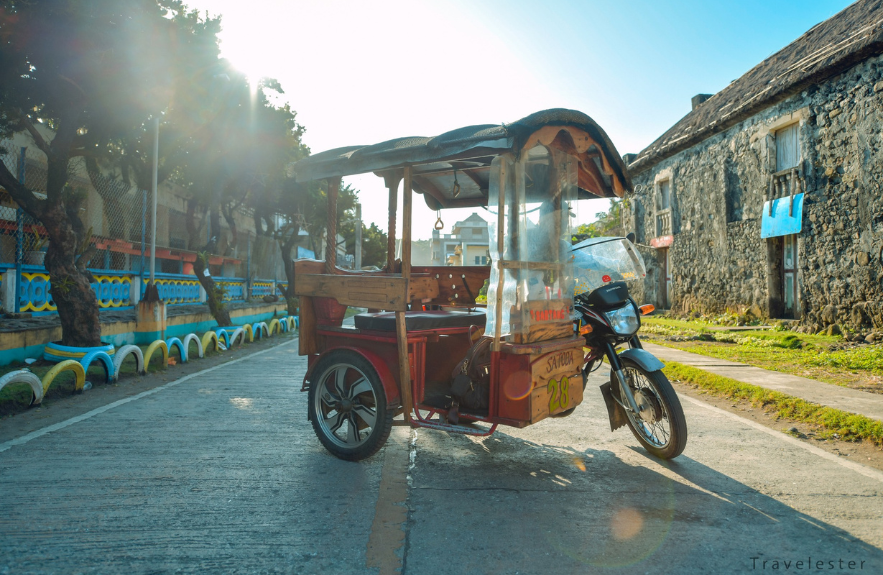
The optimal season to visit Batanes is March-May: this is time of the nice warm and dry weather without strong winds or even typhoons. I flew into Basco in late March on a perfect sunny day: this was my first view of the Batan island.
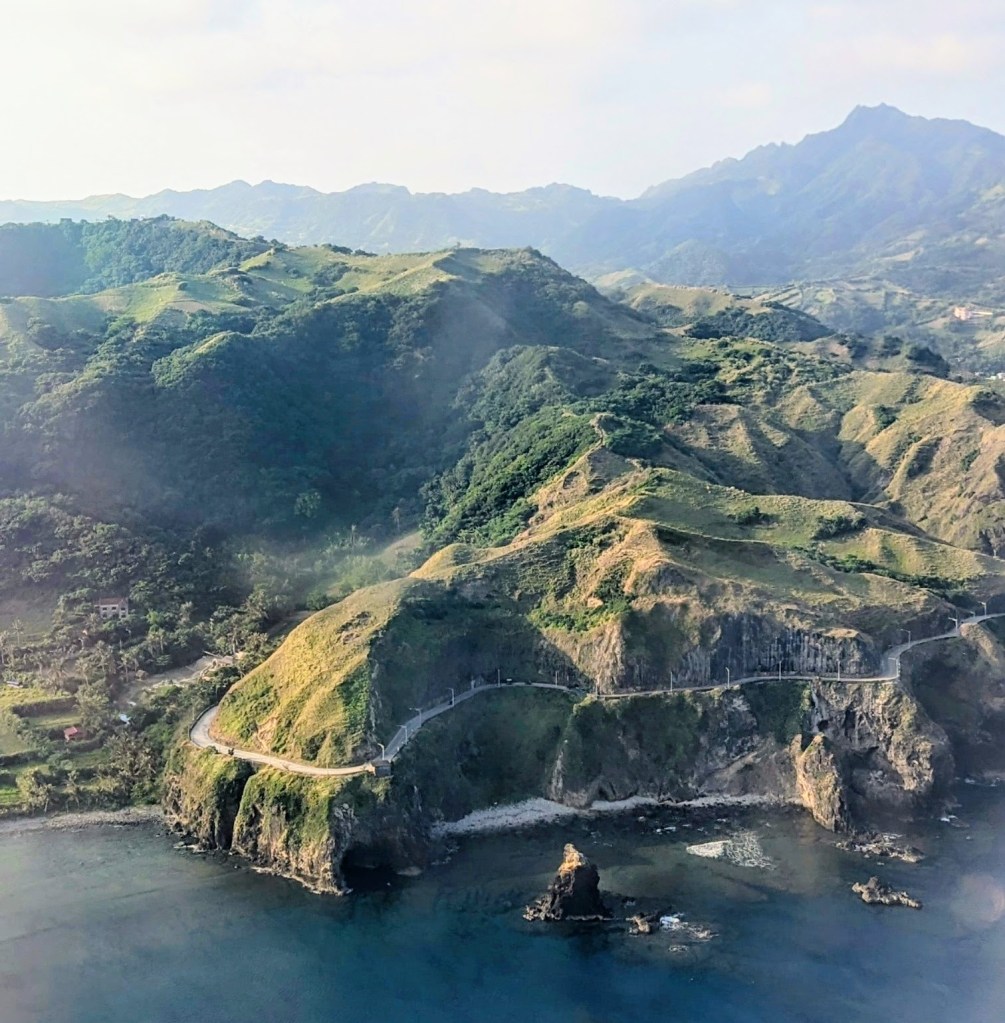

Another recommendation is to schedule arrival to Basco on Monday morning. Upon arrival (the plane lands at around 7 am), head straight to the center of town (the ride by tricycle takes only about 15 min). Each Monday, at 8 am, there is a ceremony of raising national flag in the front of provincial capitol. It is a picturesque and nicely orchestrated ritual plus you will see the whole local political establishment. While taking pictures (see below), I noted that the man on my left side was constantly starring at me. Later I was told that this was actually…the governor of Batanes. Well, I guess I missed the chance to introduce myself and make a well-connected local friend.
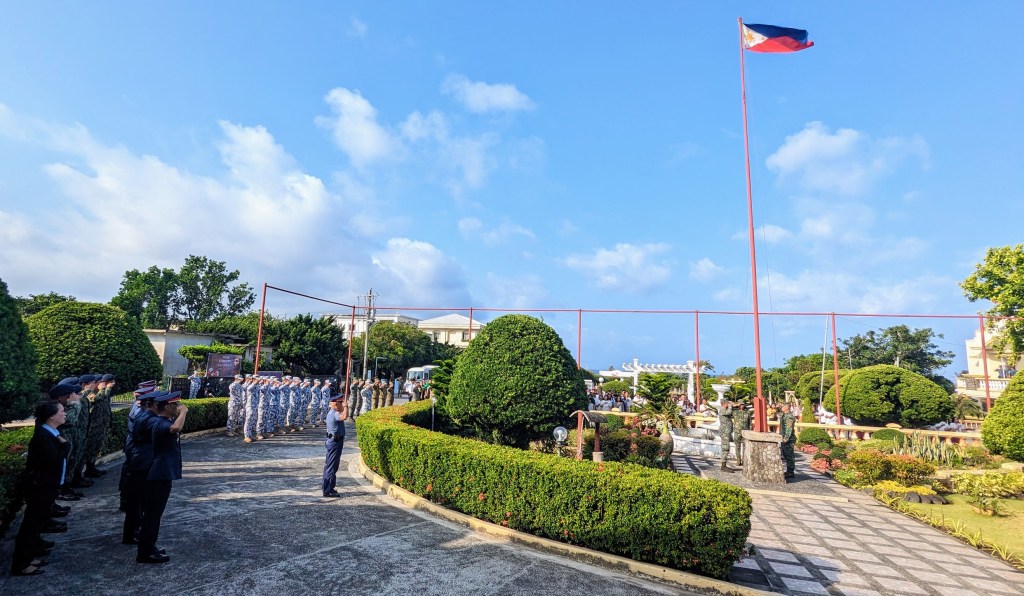
After watching flag ceremony, I did not stay in Basco, but headed to the town of Ivana which is about 20 km / 13 miles south of Basco. The plan for the next morning was to take a boat from there to Sabtang island. My driver and host, the owner of hotel in Ivana, Robert Gabas, told me that Ivana has a reputation of the intellectual capital of Batanes, because many local celebrities originate from Ivana’s families. The coastal road between Basco and Ivana is fairly picturesque, and it passes through the town of Mahatao.
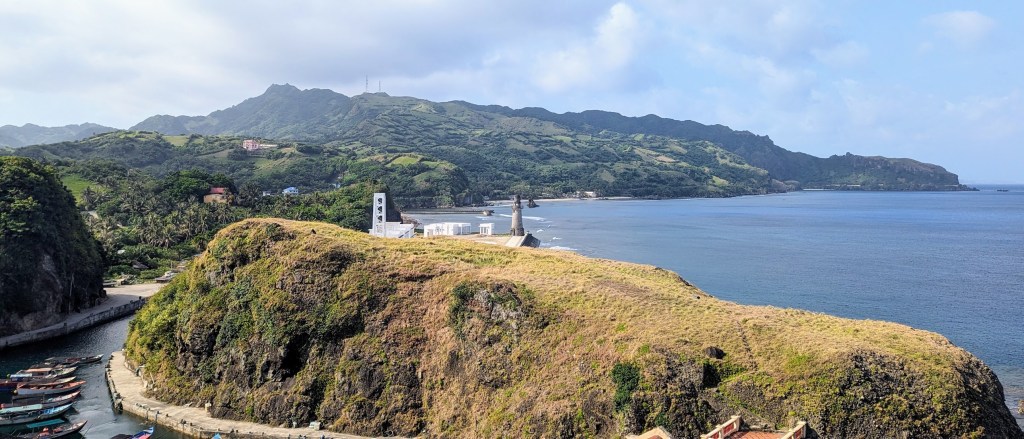
My host Robert turned out to be an indispensable source of all kinds of information on Batanes: their history, traditions, economy and politics. Born and raised in Ivana, he was a fisherman and boats builder. But then, about ten years ago, Batanes began to attract tourists and Robert ventured into a new stage of his life by opening a hotel and offering other tourist services.
On the way to Ivana, I was surprised by the quality of highway: it was much better than what I have seen in other parts of the Philippines. Later, as I traveled through Batanes, this first impression was constantly confirmed: many roads appeared to be brand new and good quality.

In some places – especially, within villages and towns – the coastal roads were even separated from the ocean by a solid stone wall of about 3 meters / yards high. They were built for protection from the waves in the season of winds and typhoons. In “peaceful” times of year, though, one can leisurely stroll on pedestrian paths constructed on top of these walls.

Another interesting facts about Batanes is that this province of the Philippines has practically “zero” crime rate and, at the same time, the highest ratio of teachers to students in the public schools. According to country’s official statistics Batanes rank number 6 out of 82 Philippines’ provinces by the overall Human Development Index All things considered, it appeared that Batanes are not a bad place to live in the Philippines.
After about 30 min of drive from Basco, we arrived to Ivana. The entrance to the town is marked by a “Welcome to Ivana” memorial which in fact incorporates three different monuments, including (at the back) kneeling “Father of the Philippine Revolution,” Andres Bonifacio – the man who was a leader of the movement that sought independence of the Philippines from Spanish colonial rule.
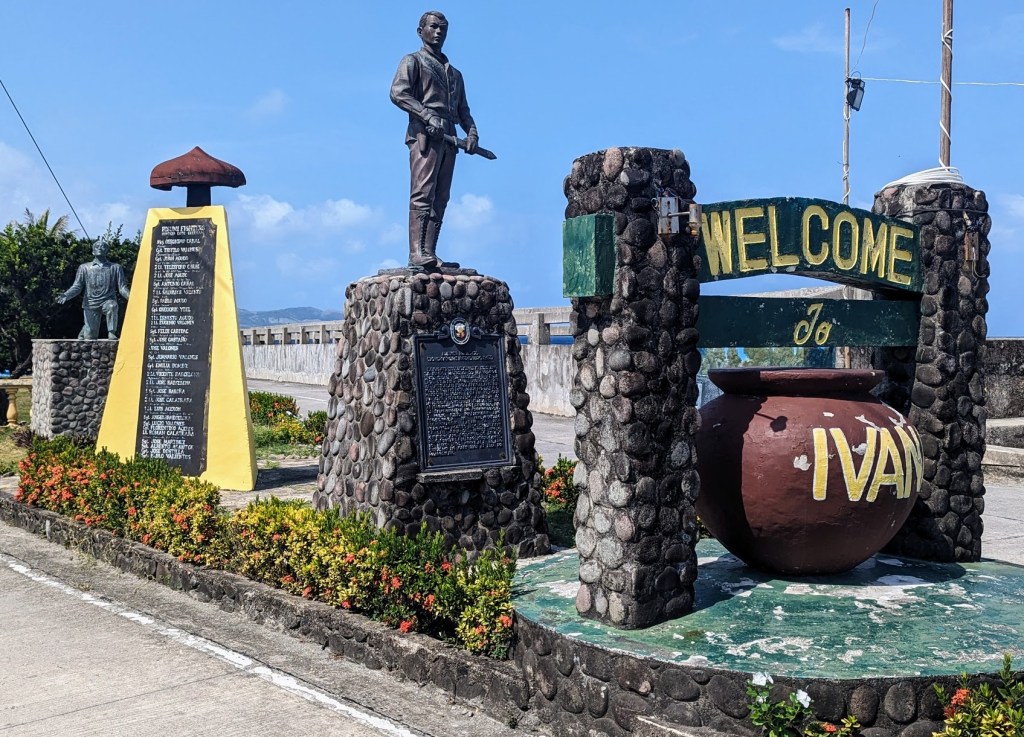
Robert’s Siayanrock hotel in Ivana looked brand-new and it was actually much better than what you would typically get in the Philippines for $20 per night. The room was spacious, with airconditioning, hot shower, and a balcony overlooking local street life.

I also liked the sign posted in reception area: “Remember that happiness is a way of travel – not a destination.” Definitely my kind of philosophy.
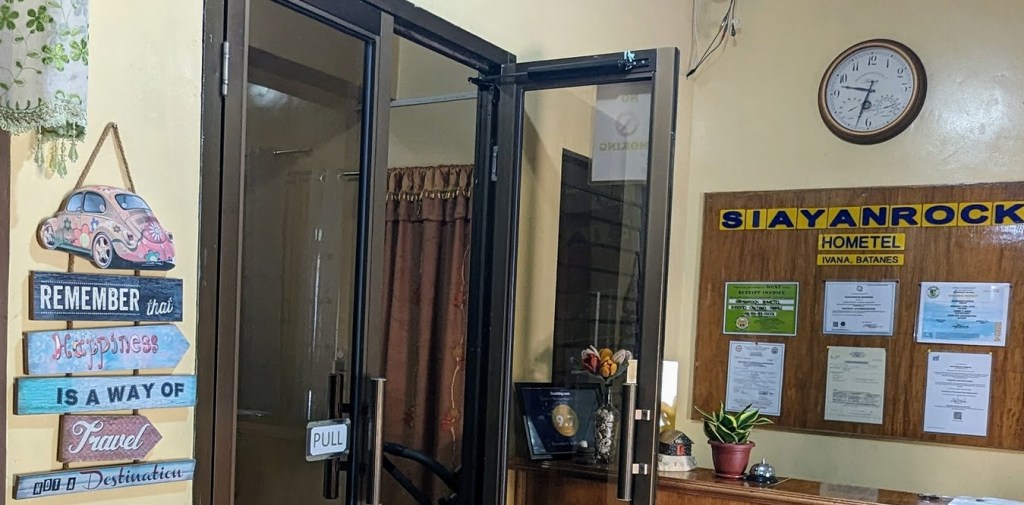
Siayanrock hotel was originally thought to be a Robert’s family house. But when he launched his tourist business, the house was expanded into a nice accommodation. As to the name “Siayanrock,” there is a story behind it. Robert was fishing near remote uninhabited island of Siayan, when his third child, the daughter, was born. She was named after this island: Siayan. The rest of the hotel’s name – ROCK – is an acronym for the names of the other family’s members: Robert, Ofel, Caryll and Kristianne (the last son, Ismael, was not born yet).
Anyway, I liked Siayanrock a lot. If you decide to visit Ivana, you can reserve on Booking.com or get in touch with Robert directly: +63-919-898-3461
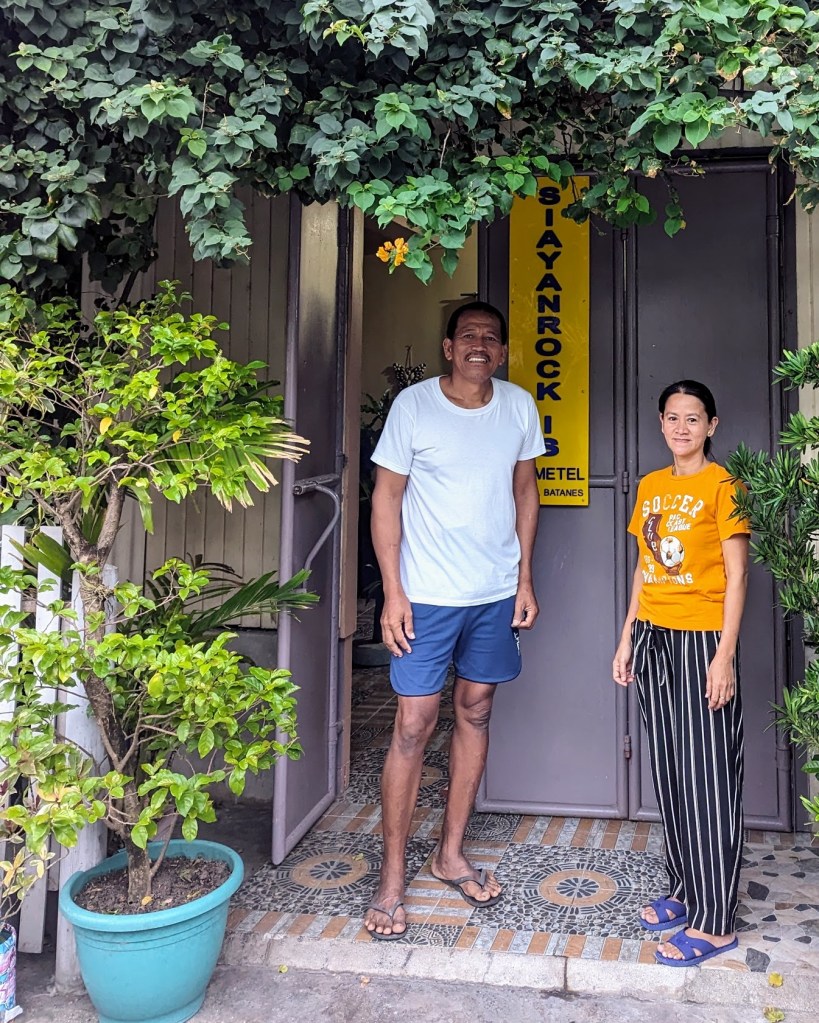
In early afternoon, I took a bicycle (free from Siayanrock hotel) and pedaled to the White beach. It is an easy and scenic ride of less than 6 km/4 miles along the ocean. Generally, the Batanes do not have good beaches: most of the coast is formed by stones and rocks. The White beach and the adjacent Blue lagoon are among few places where one can go for a relaxed and safe swim. Problem was that I did not check the schedule of the tides which is a must-to-do on Batanes. It was a low tide when I came to the White beach: not a good time to go into water.
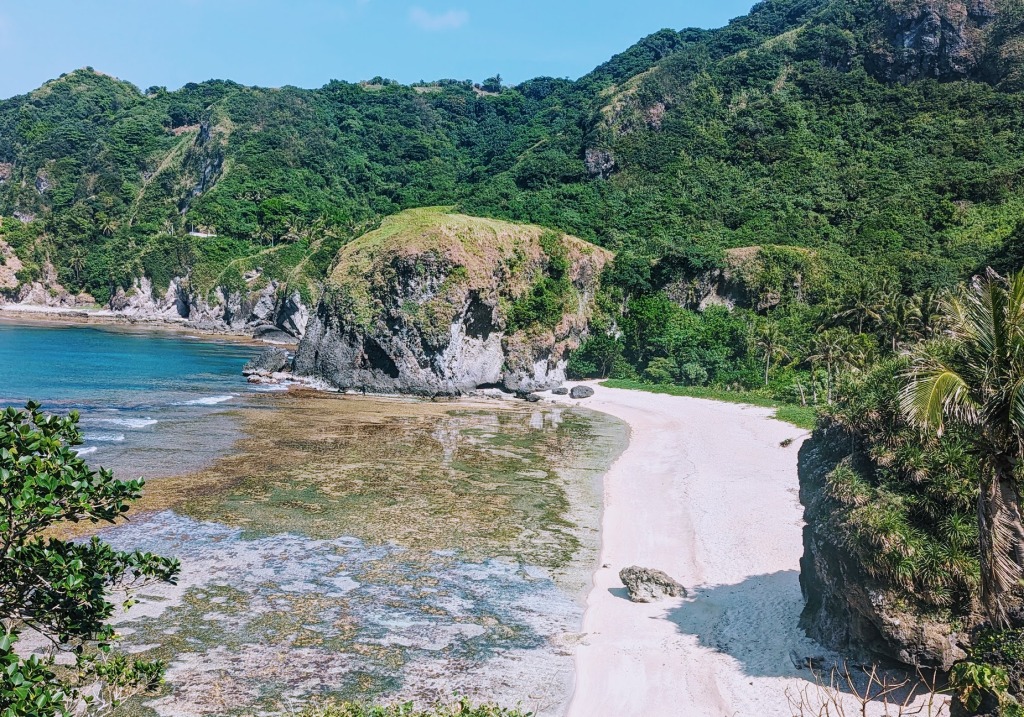
Predictably, the nearby famous Blue Lagoon did not look any better.
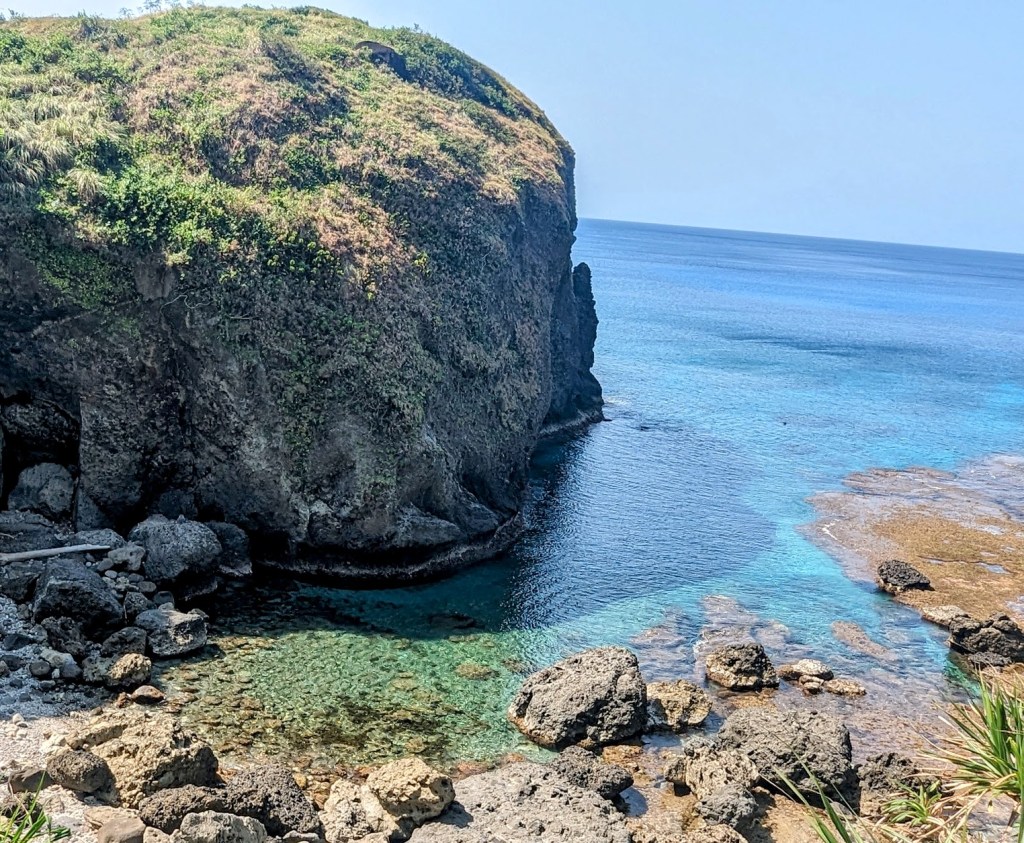
Nevertheless, I decided to stay for some leisurely siesta, and was “triple” rewarded for this decision. First, a fisherman came and used an old, presently rare, technology to catch fish. Walking on the edge of the reef, along the line where there was a drop in the water’s depth, he used hammock-like looking net to snatch the fish which was jumping in the surf strip.
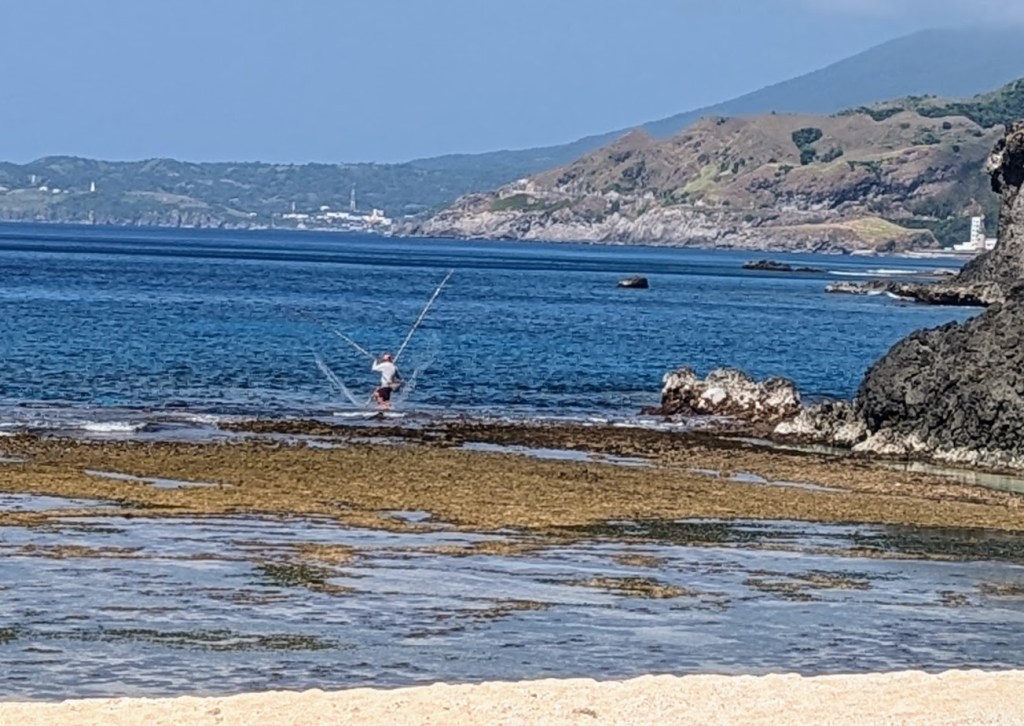
Then, it occurred to me that I can also walk (in the protected water shoes!) to the edge of the reef, jump in the water and go for some snorkeling. And it was a perfect spot: the corals there were alive and the colorful fishes abundant.
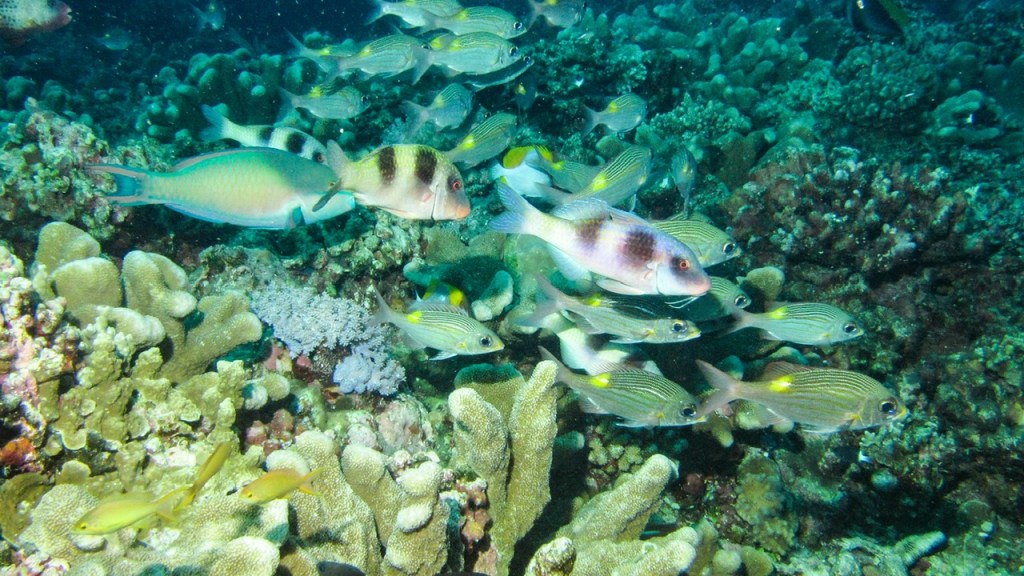
After snorkeling, I was enjoying sunshine and salty breeze on a totally deserted beach, when three gracious cows walked in and joined me.

One of the cows walked behind my back and – with her huge tongue – gave me a nice “neck and shoulder scrab.” I suspect that she liked the saltiness of my skin.

And then the cows walked to the water and began picking up and eating something from the tide pools. Well, in the final count, most of us really like seafood…

When I returned to Siayanrock, Robert offered a tour of Ivana. We first walked to the House of Dakay. Built in 1877, from the limestone and corals, and covered with thatched cogon roof, it is the only remaining traditional house on Batanes which survived the powerful earthquake of 1918.
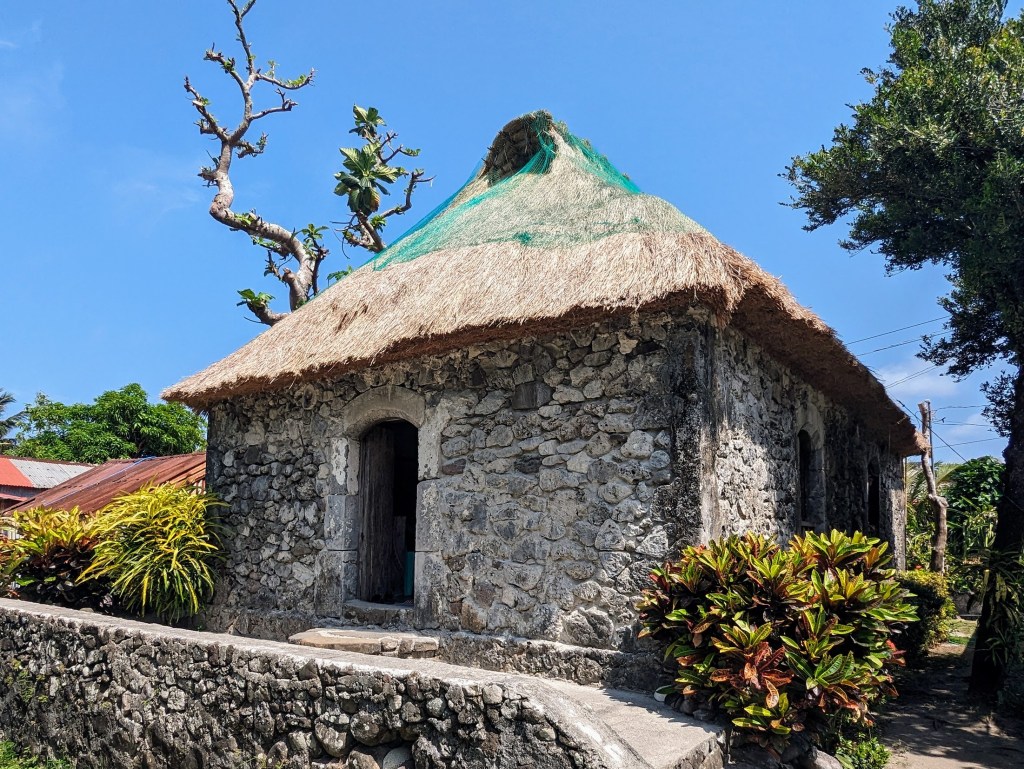
Remarkably, the house is still occupied by the same family: the grand-grand son of the original owner lives there. Sure enough, Robert knew well this fellow, and we had great conversation about how the life on Batanes used to be 40-50 years ago.
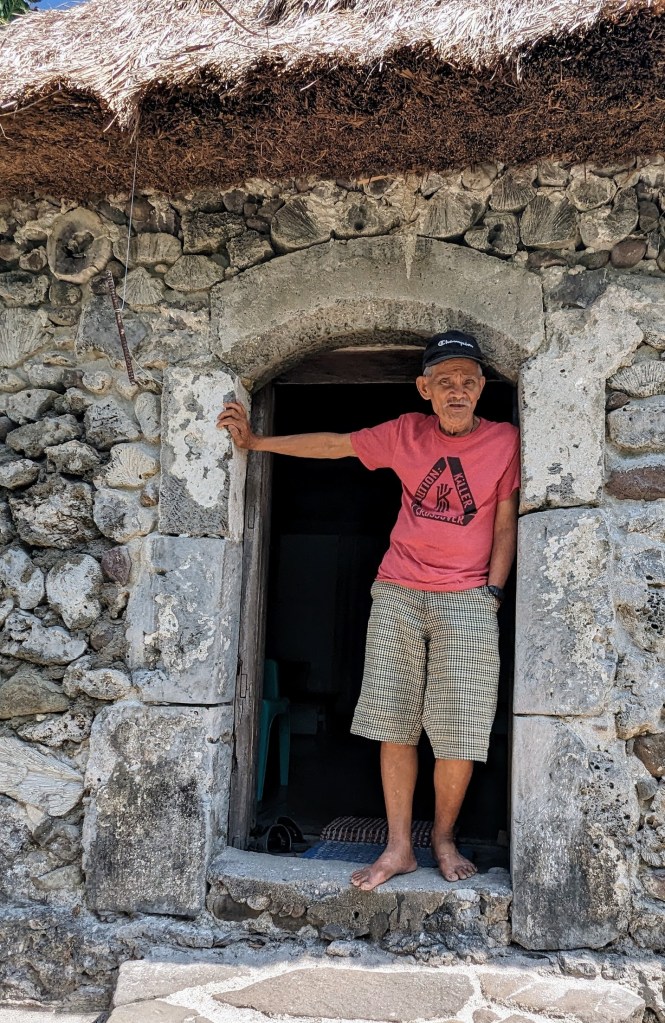
This conversation prompted me to ask one particular question. In many places in Ivana (and later everywhere in Batanes), I saw the houses which appeared to be once nicely looking homes but now in a clear state of decay. I asked Robert: Why they were neither repaired by the owners nor sold to someone to either fully demolish or restore to original state?
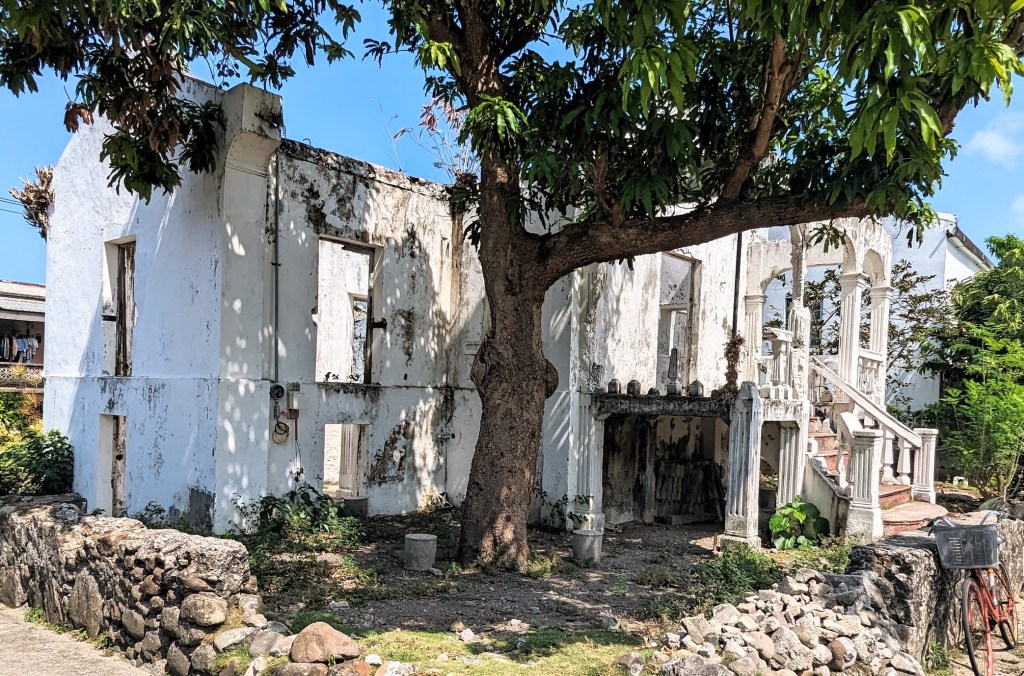

The answer was that Batanes experience depopulation. Young people move to major urban centers or abroad in search of better living. However, because of the local law, they cannot sell their family properties to any “outsider:” that is, not only foreigners but even people from other provinces of the Philippines cannot buy land and homes in Batanes. As a result, these former mansions remain in collective possession of the families which can be spread all over Philippines or even worldwide. Unless someone in such family is interested and wealthy enough to buy out the entire property, the houses continue to slowly collapse.
But at least one structure in Ivana has survived and will survive everything: the so called Spanish Bridge or the Bridge of San Jose. It was constructed in 1866 by Dominican missionary priest, Fr. Fabian Martin. The bridge’s massive stone arches and barrel-like vaults have never been repaired and yet remain fully intact despite all typhoons and earthquakes which hit Batanes regularly.

The irony is that couple more bridges were built in Ivana more recently and literally side-by-side with the Spanish Bridge (see picture below). But neither of them lasted for more than a few years: they constantly needed some repair and update.

The reason why Fr. Fabian built Spanish Bridge was simple. In rainy season, powerful stream of water divided Ivana in two parts. The bridge helped children and elderly people to walk to the church which was constructed at the south end of the town. And this was our next destination: the Church of San Jose el Obrero. Later, through the trip in Batanes, I will see many more examples of well preserved 200+ years old Catholic churches which date back to Spanish colonial times. But this was the first encounter and I was impressed.
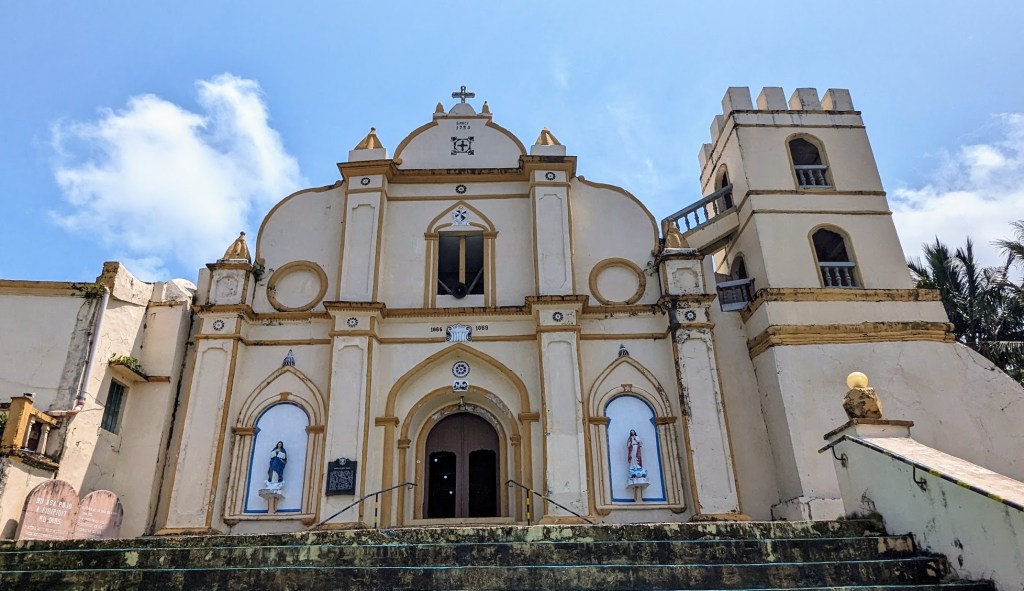
Inside, the figure of Jesus Christ looked – anthropologically speaking – definitely more Filipino rather than Caucasian.
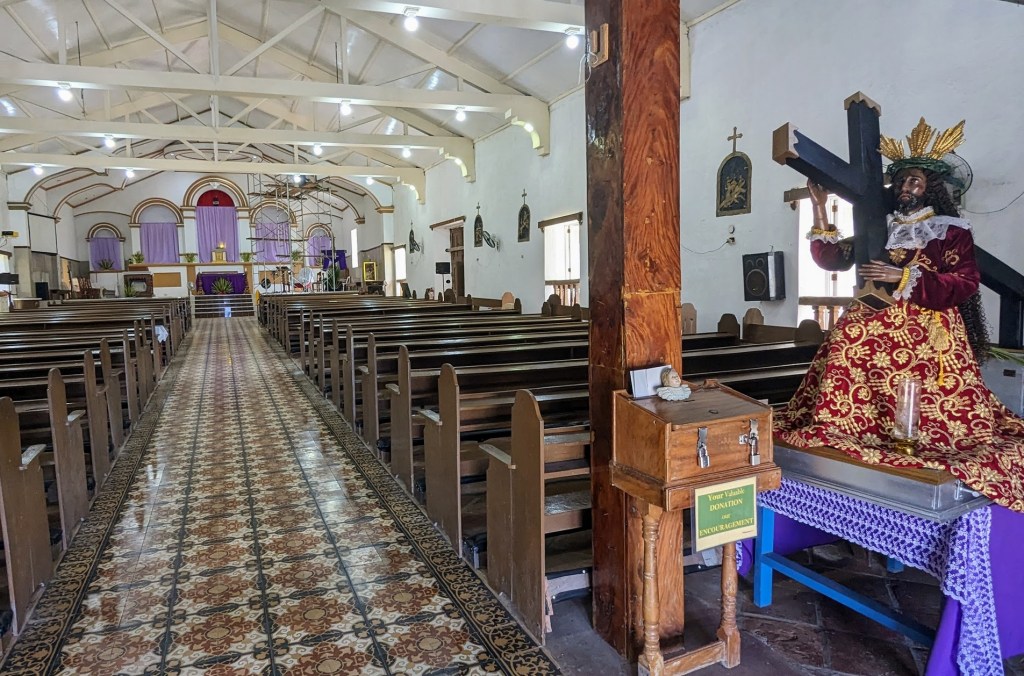
If archeology is among your interests, walk behind San Jose Church. There you will find the ruins of what used to be the altar part when the church was originally constructed: apparently it was considerably larger back then.
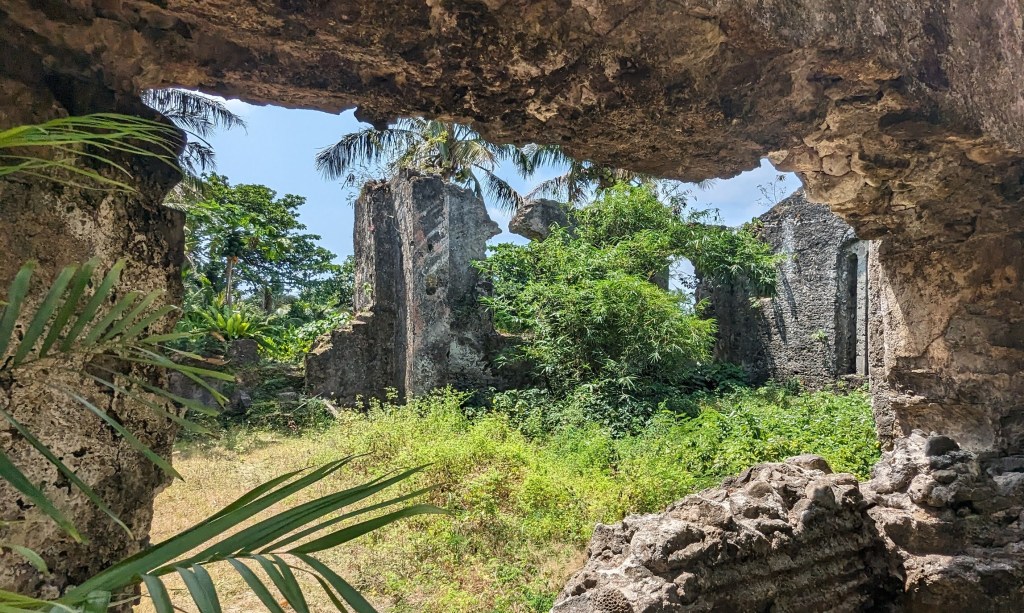
From the doorsteps of the church, the view of the old fountain, brand-new port and light house was simply picture-perfect!

Most lighthouses on Batanes are fully open for visitors and the one in Ivana was not an exception: no need a ticket or a guide to go there. Here is the view from the lighthouse’s observation deck.
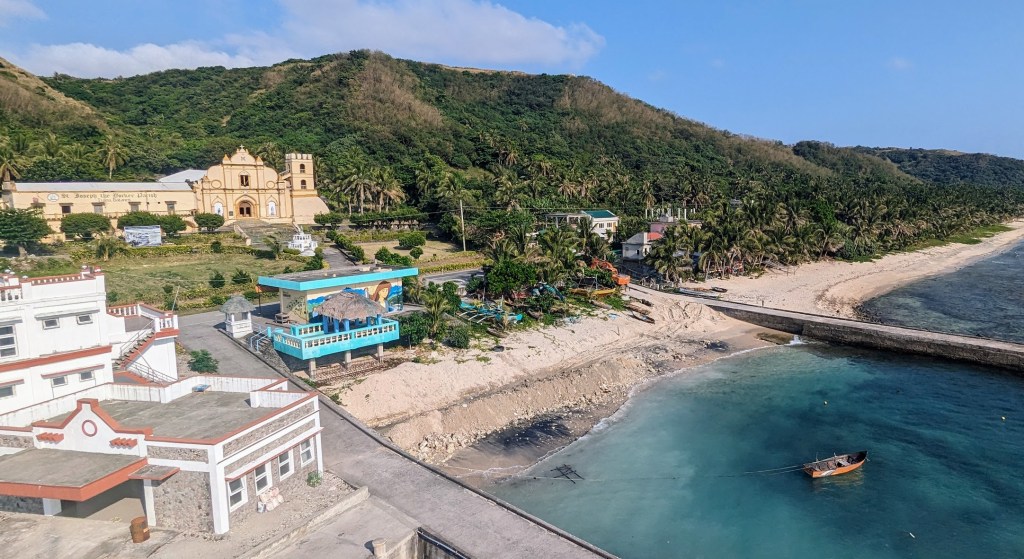
It was getting late and I thought of returning to the hotel, but Robert pointed somewhere further south along the coast and said: “We are going there for the sunset.” I did not ask any questions and simply followed. It turned out that in addition to hotel in Ivana, Robert has another property. Perched on the top of the cliff, his land offered great view in both directions: toward Ivana and along the coast to the southern tip of the island.

We walked to the beach where a huge rock looked like a cow. In Robert’s explanation, however, the rock was more similar to a dog and there was legend related to it. Once upon a time a fisherman lived here. HIs dog always accompanied him to the boat and then waited on the beach until he would return with the catch of the day. But one time the fisherman did not return. Day after day, the dog kept waiting, but to no avail. Gradually, the dog converted into the rock: still facing the ocean and waiting for his owner.

We walked back to the top of the cliff and sat in a spacious gazebo which was built for the visitors to Syanrock hotel. Robert’s idea for the future is to bring here tourists and serve them traditional Ivatan meals: lunches “with ocean view” and dinners “under the stars.” Tonight, however, we simply watched sunset and talked about how people live here. And this was probably the best part of my first day on Batanes.
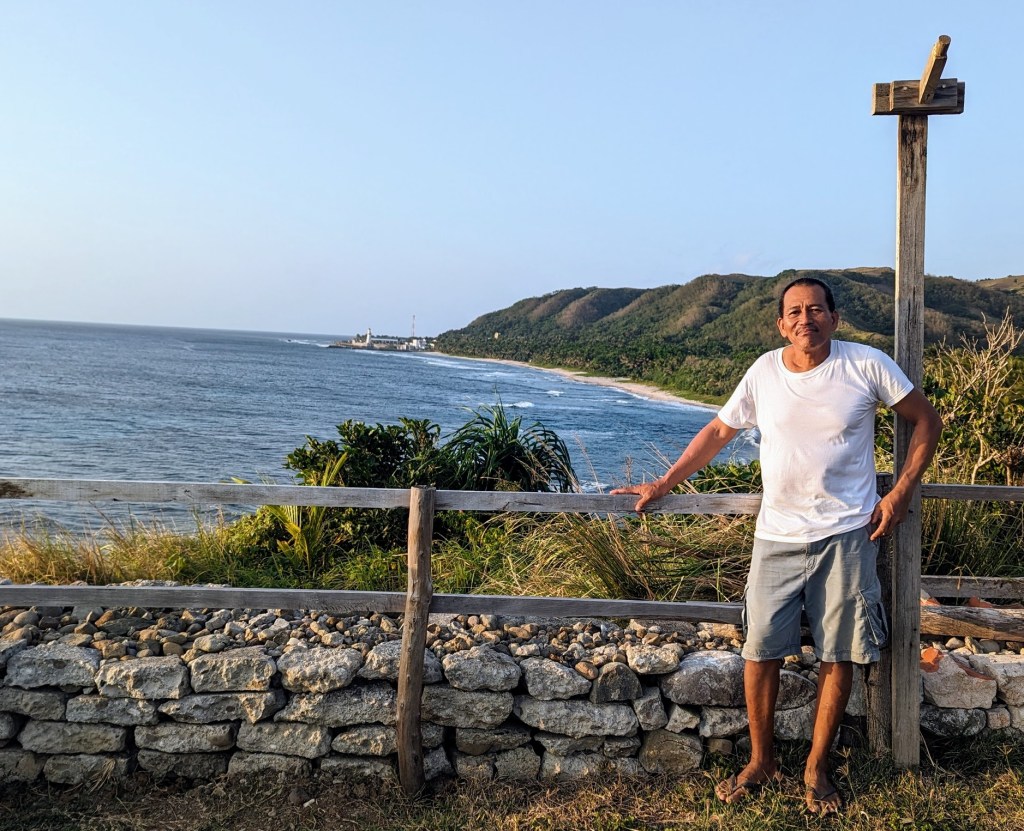
The day was almost over, but not quite yet. Back in the hotel, Ofel, the wife of Robert prepared an excellent dinner of the local lobster (in the Philippines, Batanes are especially known for this delicacy), some soup and vegetables. Finally, going to the bed, I felt like it was one of those rare days which simply cannot be any better.

The next day, my destination was Sabtang. With only about 1,800 inhabitants it is the smallest of three inhabited Batanes islands. Yet, the people of Sabtang distinguish themselves clearly from the rest of the province. Their distinct history (Sabtenos resisted Spanish colonization for a much longer period than other Batanes) and isolated way of living (which is even further separated from the outside world than Batan island) resulted in close-knit and somewhat “lost in time” community. It is also Sabtang where one can see the best examples of the traditional Ivatan stone houses.
Daily boats from Ivana port for Sabtang leave at around 6 am and the ticket costs about $8. Travel distance is only about 4.5 kilometers (2.8 miles), but in the season of strong winds and typhoons Sabtang could be easily disconnected for days from the rest of the world. Upon arrival to the port, I found there a good number of other tourists. All of them were Filipinos and they were visiting Sabtang for just half a day and as a part of their package tours to Batanes.
It is time to explain something about tourist industry in Batanes. Vast majority of visitors to the islands are not foreigners, but people from the other parts of Philippines. And nearly all of them travel via package tours: that is, they are always accompanied by the guides, their itineraries are precisely scheduled, and they move from one point of interest to another in airconditioned minivans with little opportunity to communicate with locals or explore beyond what is planned by travel agency. This is how a typical tourist group in Batanes looks like:

Besides me and handful of locals, everyone else on board was part of various package tours. And I was the only one who was planning to stay overnight and explore the island after all other tourists would be gone back to Batan in early afternoon.
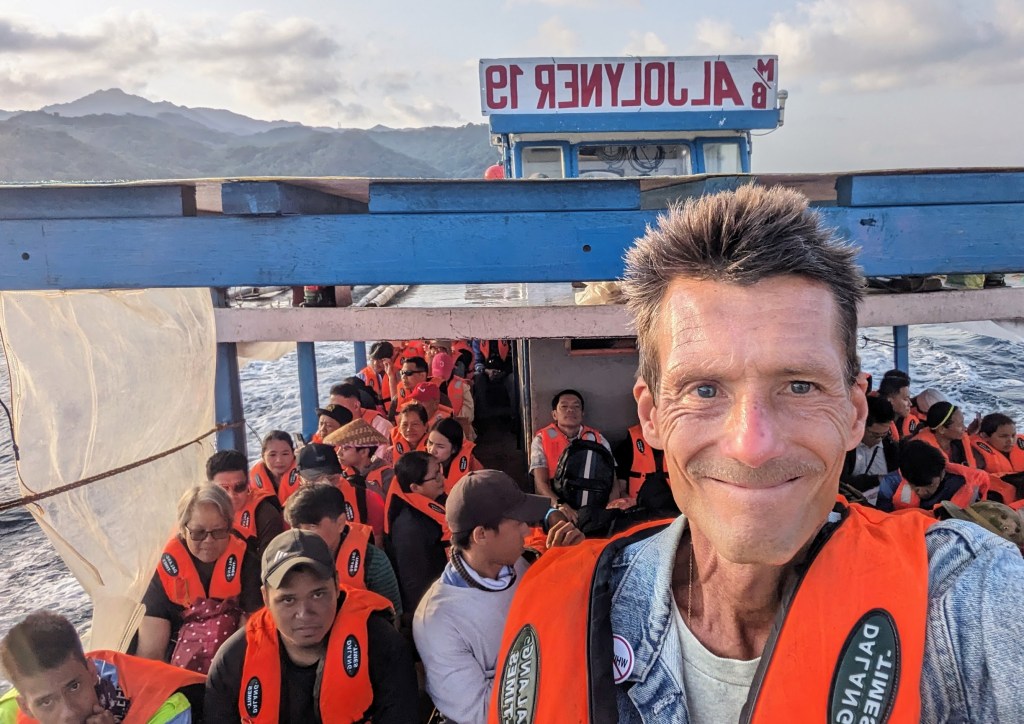
In about 20 minutes, the first sight of Sabtang, came into the view.

On Sabtang, I booked a guesthouse called Pananayan Pension. As we approached harbor, I figured out where my accommodations is. Look at the bright yellow building, right next to the lighthouse.

After disembarking, all other tourists were rushed by their guides to waiting minivans. They were on a tight schedule to see the island in just a few hours. I instead walked leisurely to Pananayan Pension and checked in. There, my first cup of coffee of the day was accompanied by a great view and with the sound of waves crushing into the rocks upon which the guesthouse was built.

There are a few major tourist sights on Sabtang, and I intended to see them all. But I was also hoping to find and explore spots that remain untouched by those on a typical tourist route. I hired tricycle and asked to drive me south, to the village of Chavayan – the place where the road ends. The plan was to take time and walk back along the coast to Malakdang, where my guesthouse was. It is about 9 kilometers / 6 miles hike.
This was the first view of the Chavayan village. Looking at the green hills and coves beyond the village I regretted that I booked only one night on Sabtang: it would be great to have more time and hike further, past the end of the road and to the very southern tip of the island.
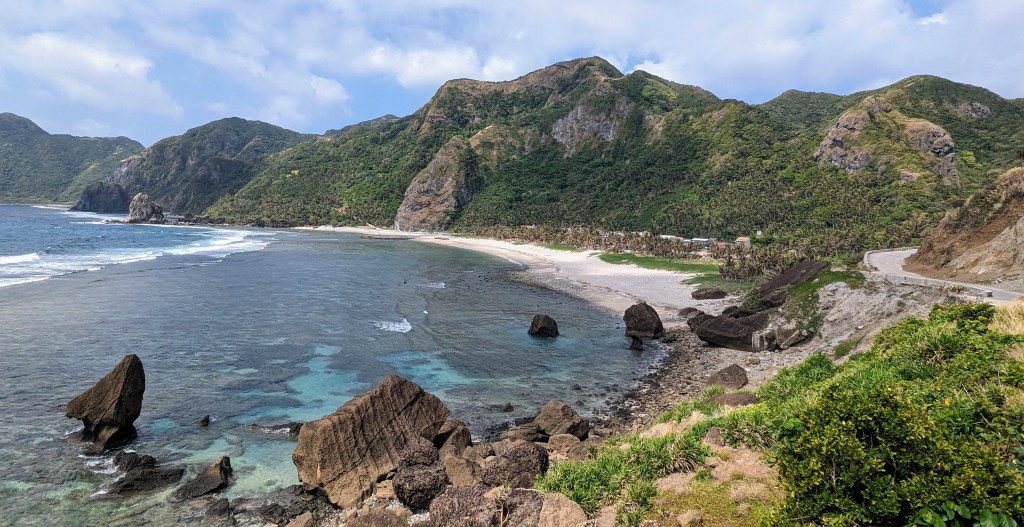
By the entrance to the village, the sculpture of the Mother of God was placed into a small roadside chapel made of corals, shells and stones picked from the ocean.
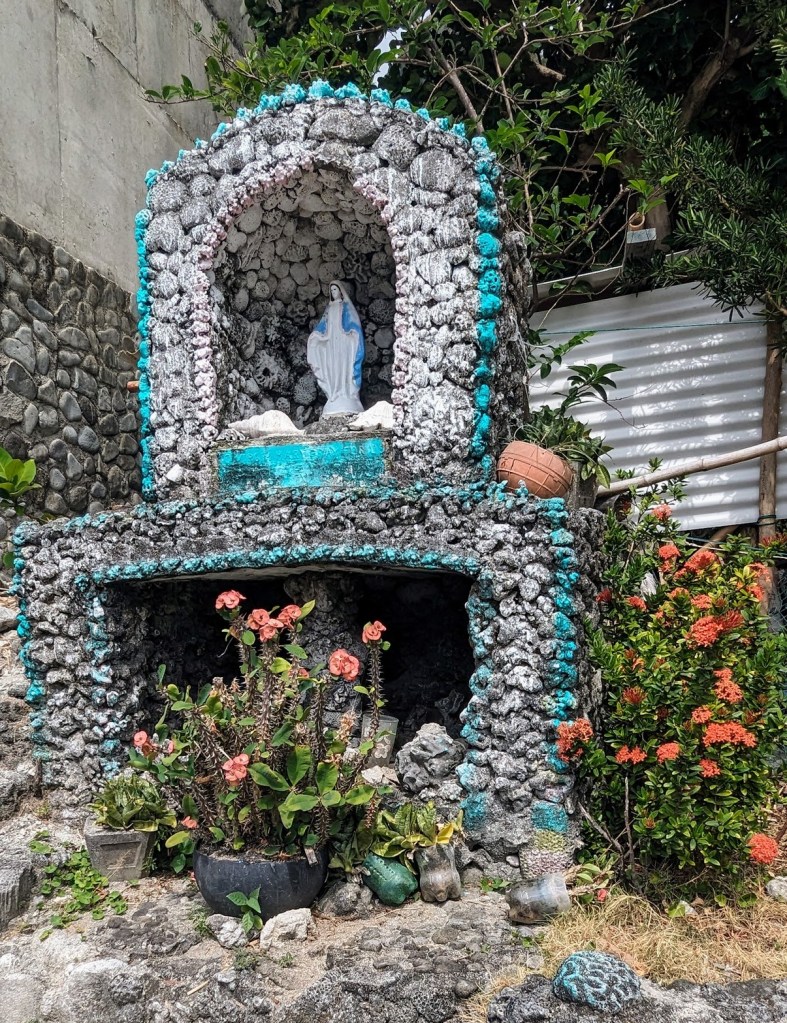
The houses in the village looked as if they were perfectly “embedded” into surrounding landscapes.

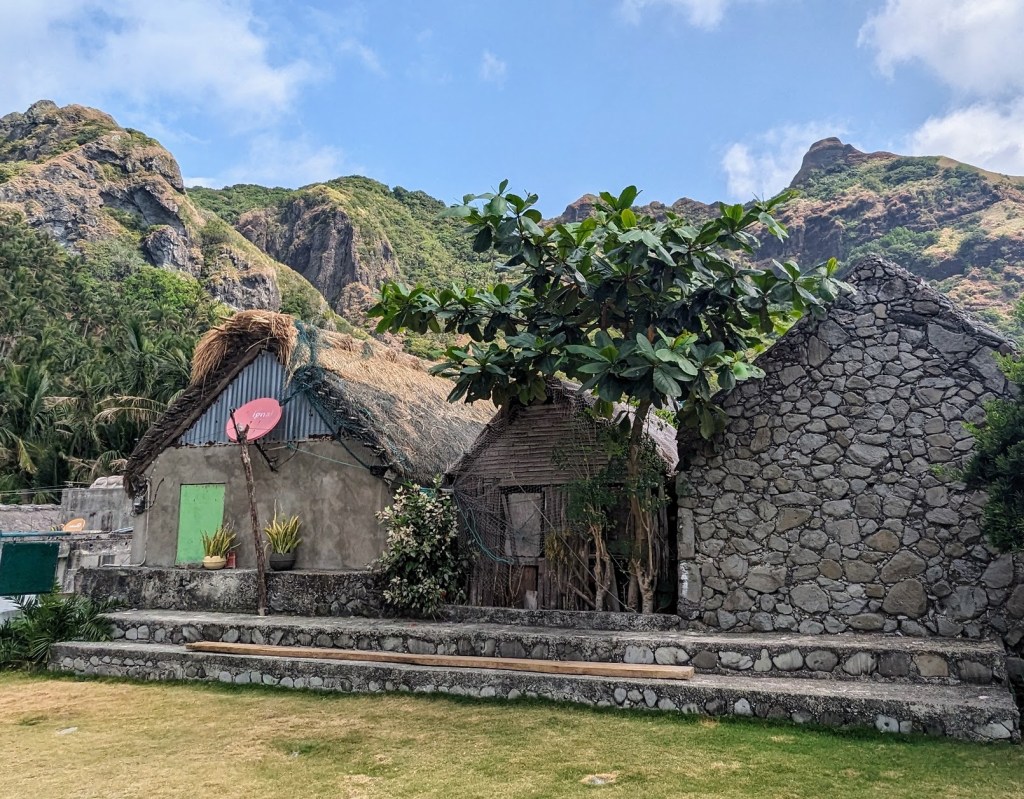
Then something surprising came into my view: apparently, this tiny fishing settlement had its own theater. At least, the sign above the door said so. Unfortunately, at this time of the day all young people were gone for the work, and a few old ladies in the village did not speak any English. I was unable to find out the story behind Chavayan theatre.
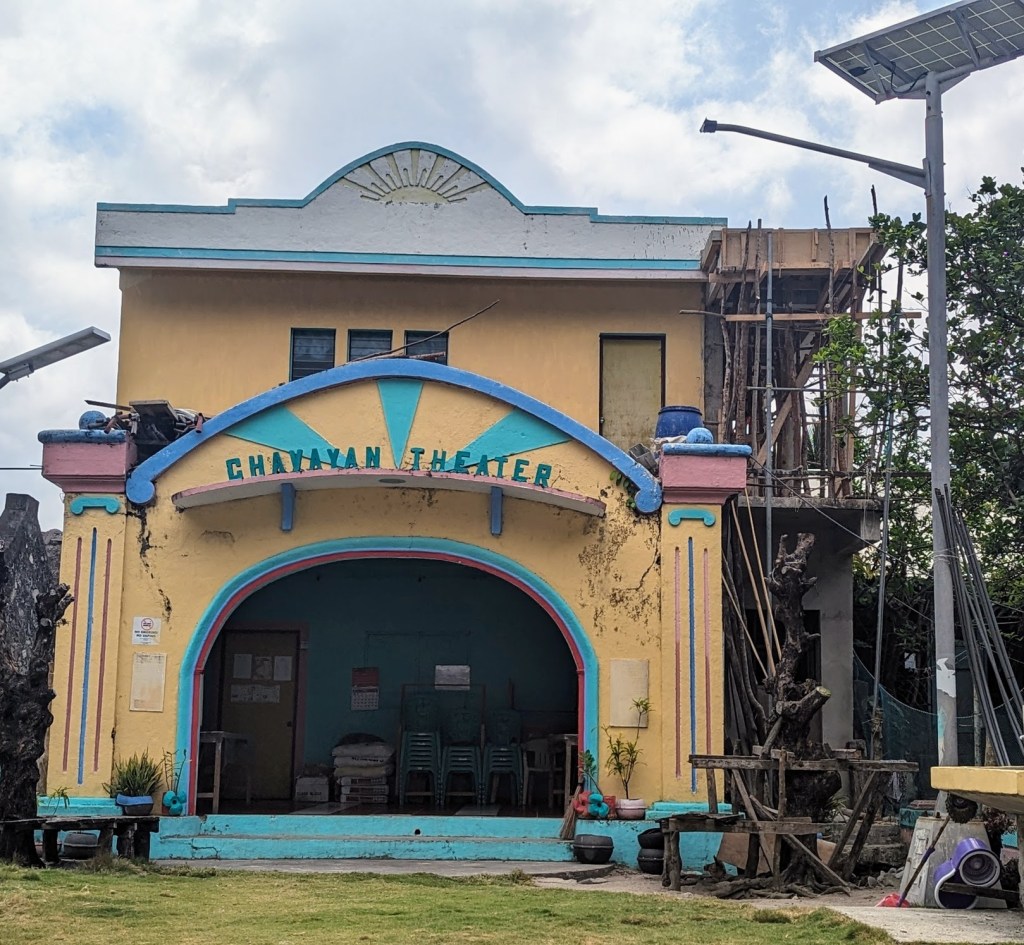
At the very end of the village, there was a small Catholic Church – the Chapel of St. Rosa de Lima. It is the only remaining church on Batanes islands which has traditional thatched roof made out of cogon grass. The sign next to chapel informed that it is “only 10 meters away from the beach” and it has “meter (i.e. three feet) thick limestone walls.” Despite the second -reassuring – part of information, I would probably refrain from worshipping there during the typhoon season when the huge waves would come from the ocean.

After exploring Chavayan, I began walking back. In less than half-hour I came to the place which Google maps call “Chamand Tinan Viewpoint.” A few makeshift stands and gazebos were selling various local souvenirs: textiles, herbal teas and tinctures, honey, magnets for refrigerators, brooms (yes!) and other things. It was afternoon and all package tourists have already passed in their minivans by this small roadside market. The vendors were surprised to see a lonely walking visitor, and I was given a lot of undivided attention.
One stand offered tasting of the homemade fruit wines – the first time I saw something like this on the Philippines. Surprisingly, the recommended way of drinking was in a combination with licking salt – sort of similar to how people drink tequila.
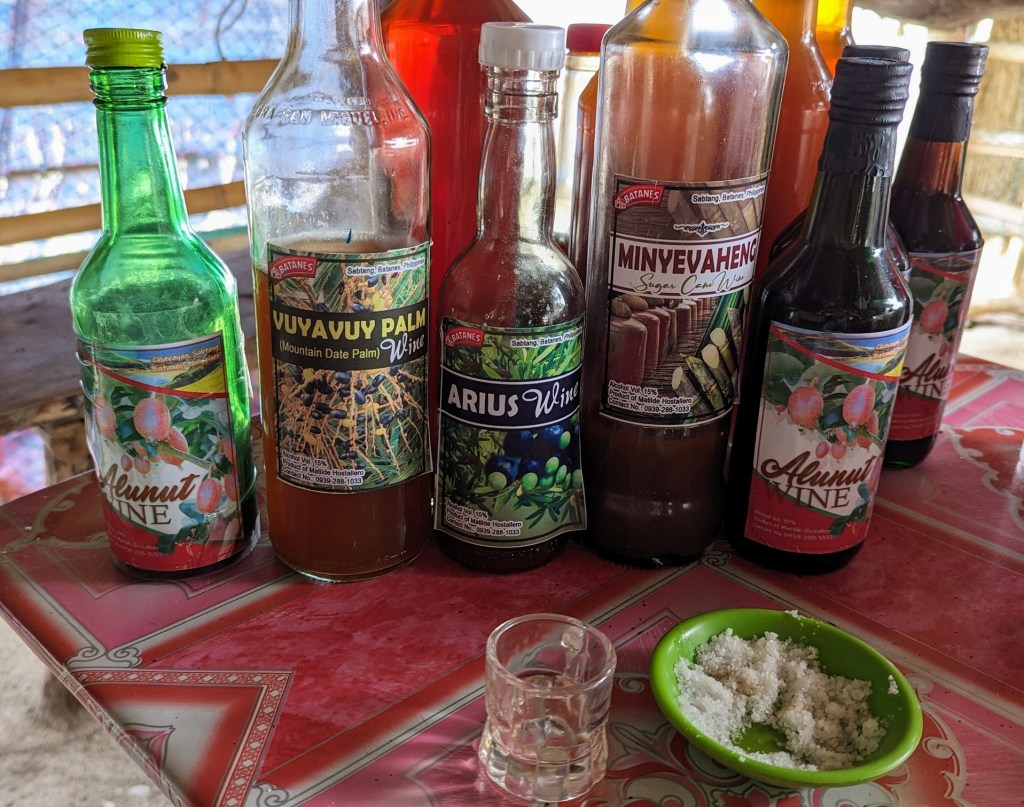
Temptation was too great and I indulged into trying all of them. My favorite was “Alunut” wine which was made out of green walnuts. It was not too sweet, had pleasant aroma and fairly intense taste.
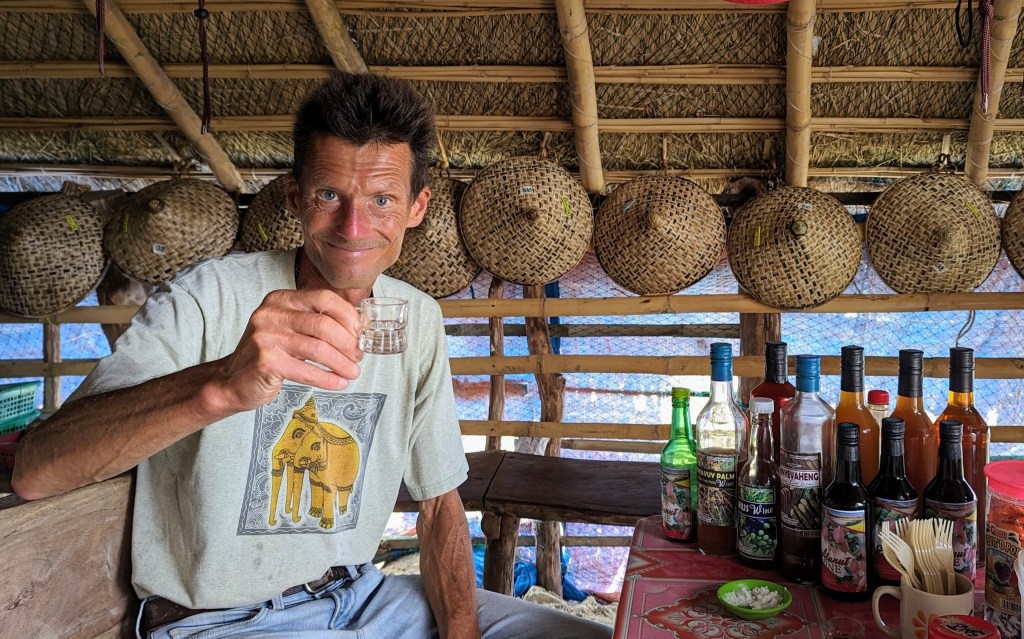
The outlook from the Chamantad Tinan Point was not bad. However, the view of the sea and coastal line was somewhat obscured by the high cliffs facing the ocean. In the distance on the left, I noticed one particular point (look at red arrow) from which the view should be much better. I decided to refresh my climbing skills and try to get there.

After 40 minutes of hiking, sweating and climbing, I was rewarded with a gorgeous coastal panorama and the view of the hidden blue lagoon.

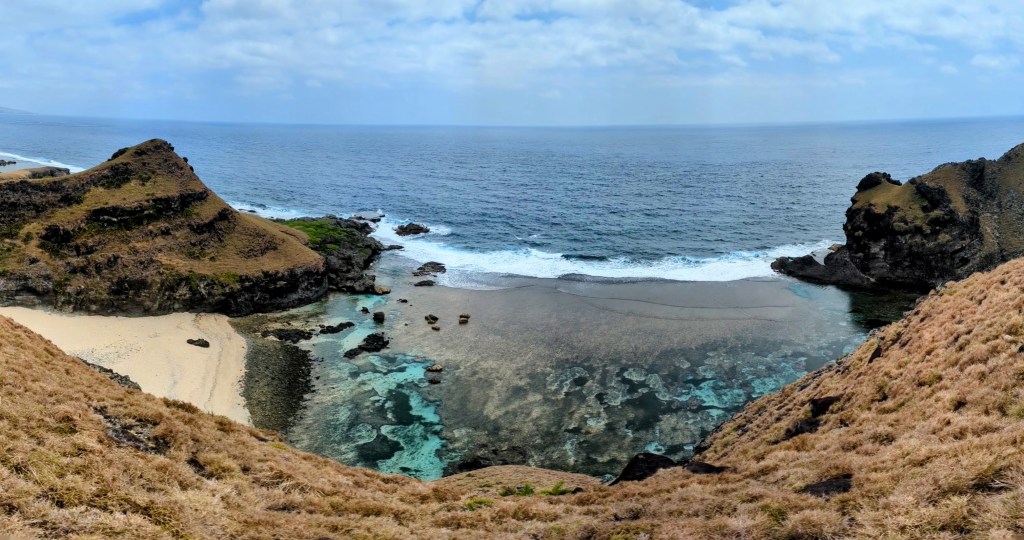
In the distance on my left, I noticed an inviting stretch of the white sand. Later, from the locals, I learned that it was a Lukuy (or Lukoy) beach – the only beach on Sabtang which is safe and good for swimming. However, it is NOT connected by a good road to the coastal highway. To get there, one needs to hike through the valley which would take time and not fit into schedule of a day-visitor to Sabtang. As a result, information about Lukuy is not offered to the tourists arriving to Sabtang.

I walked to Lukuy beach in a hope for a swim. Unfortunately, it was low tide – not the best time to go into the water. But I still enjoyed relaxing there on a white sand while looking at interesting rock formations sculptured by the ocean.
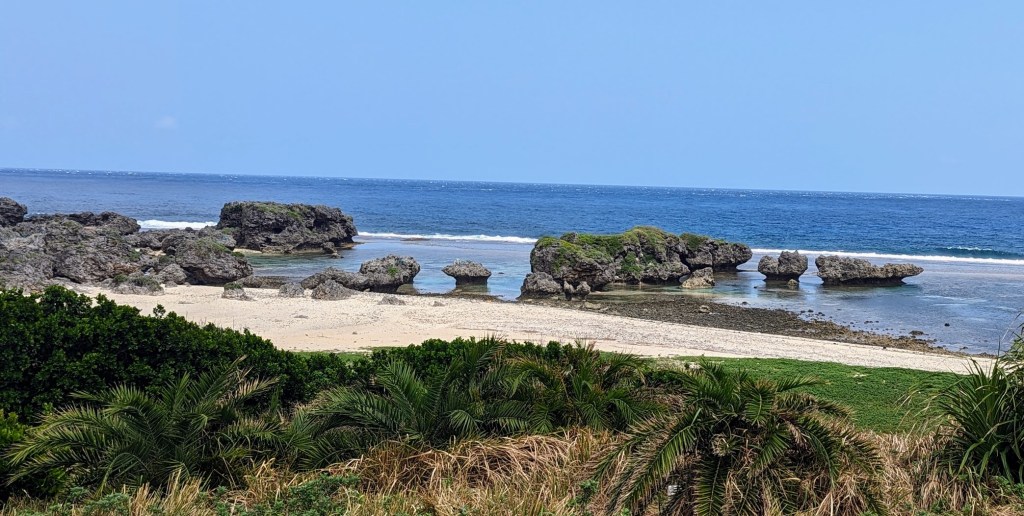
When I talked later to the locals, some people mentioned “healing qualities” of Lukoy waters. One remembered his childhood: when he was ill, his parents would take him to Lukoy beach and dig through the sand near the rocks. Eventually, they will uncover the stream of the fresh warm water running underground from the slopes of the adjacent hills inti the sea. They would bath a child with this water which would heal his illness. I have no way to verify this legend, but here is a picture (not my) of the Lukoy beach at the high tide which is great time to go for swimming and also (so I was told) snorkeling.
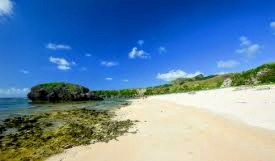
After Lukoy, the next stop further north and up the coast was Savidug village. THis is the place where tour guides usually bring tourists to show – apparently – best preserved Ivatan stone houses. Honestly, I did not feel that the houses there were any better or more interesting than what I saw already in Chavayan village. And, similarly Ivana, I saw here a few once luxuriously looking homes which were abandoned by their owners.
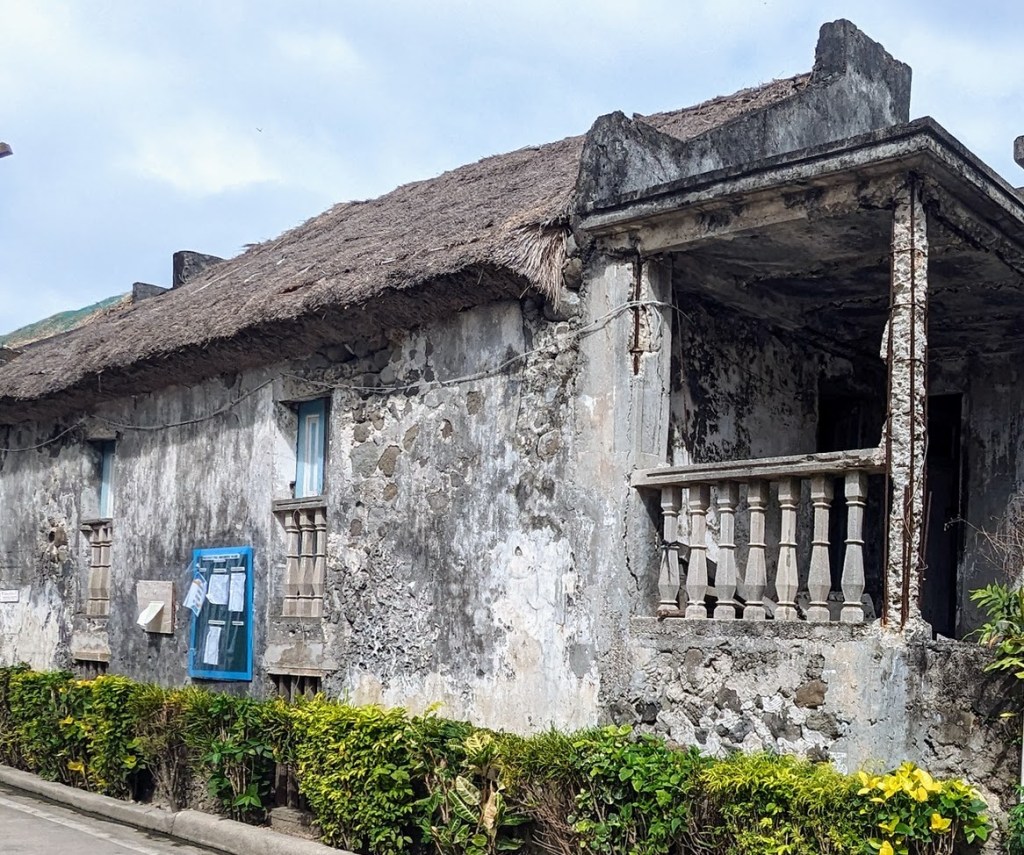
After Savidug, in less than one hour, I was back in Sabtang’s “capital” and port Malakdang. In the middle of the town’s only street, there was a school. A few educational materials were posted outside. I liked two in particular. One was citation of Barak Obama.

The other was collection of twelve placards: each representing a certain human value and each being associated with a particular month. Regrettably, no one was in sight to explain hiow a certain value relates to a particular month.


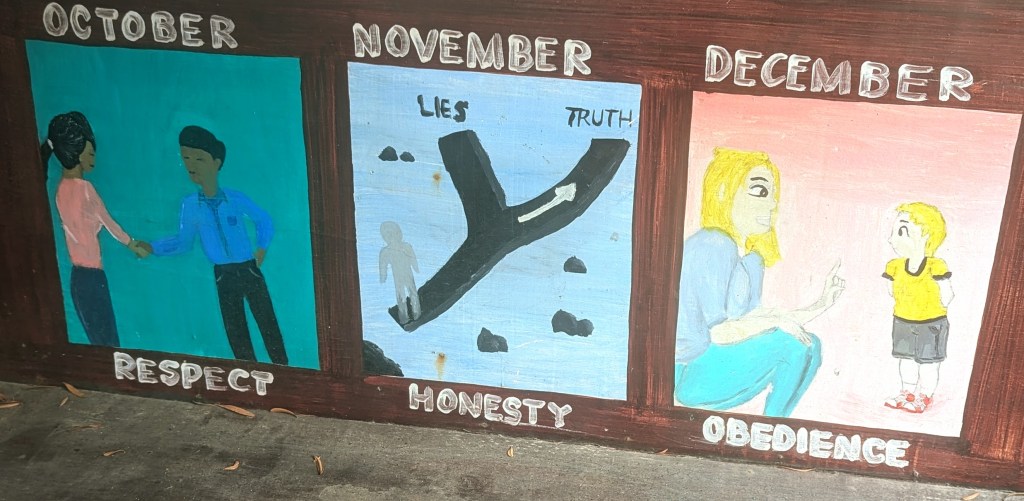
As everywhere on Batanes, there was a Catholic church with Jesus Christ looking more like a Filipino rather than “Caucasian” person.
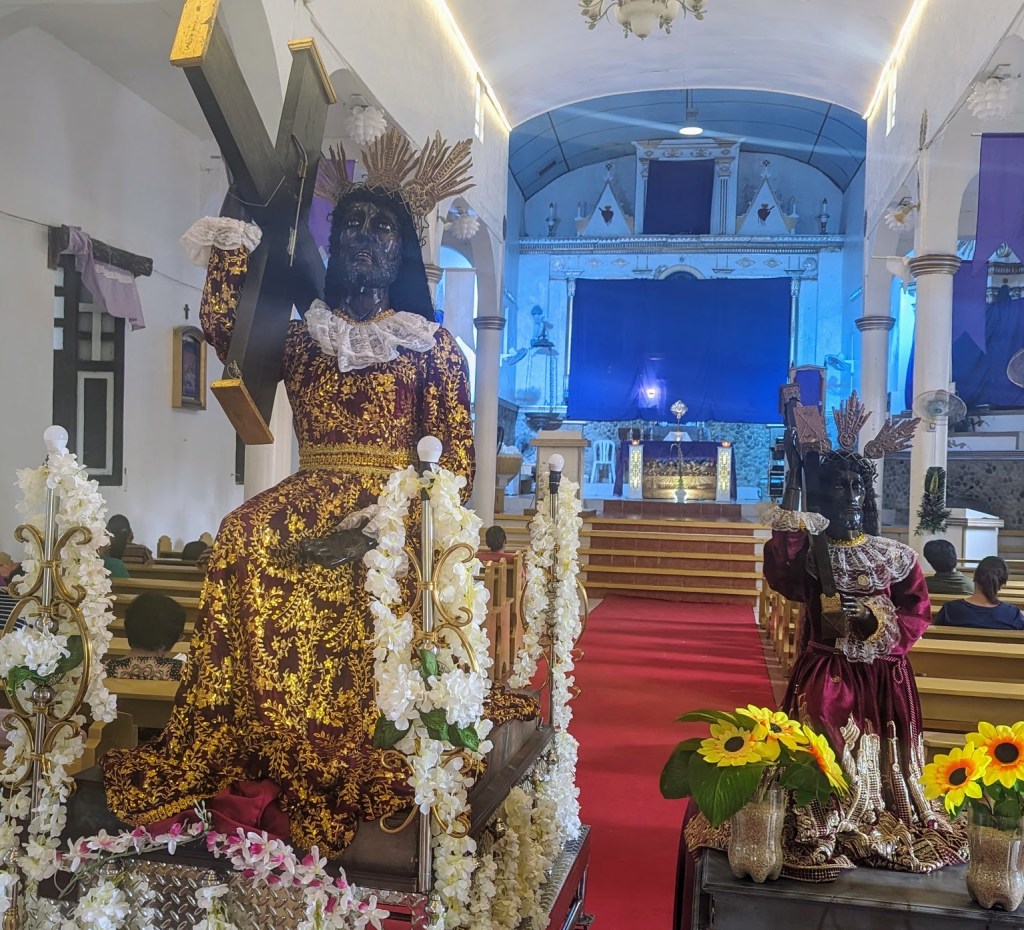
A neat park was created right in the middle of the town for communal gatherings and events.
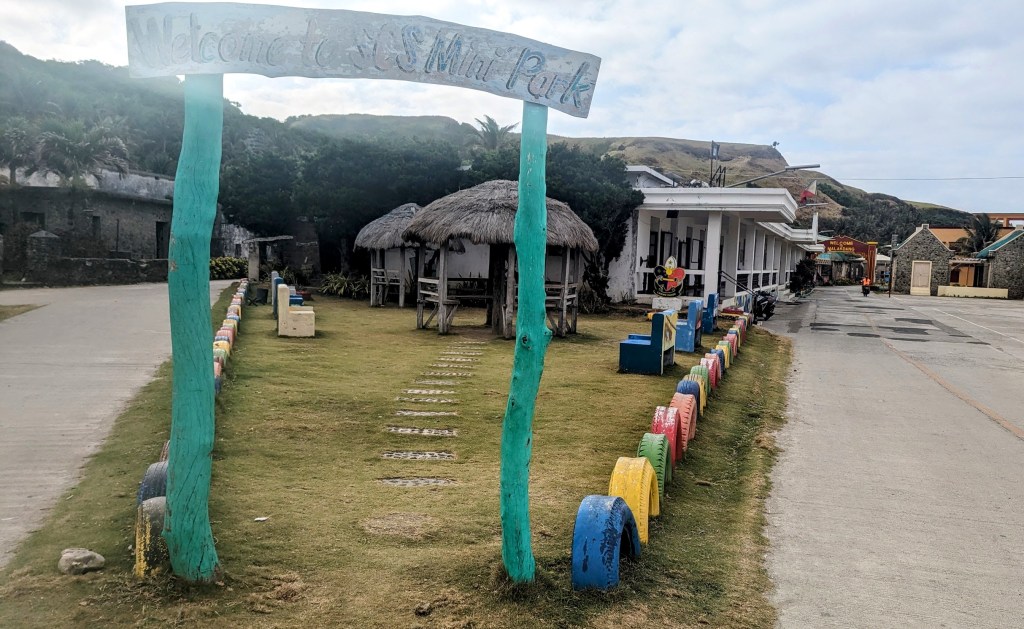
One more attraction awaited me before returning to the guesthouse: the Morong Beach on the northern tip of the island and about 3 kilometers / 2 miles past Pananayan Pension House. Unlike hidden Lukuy beach, Morong is well connected by the road and included in all tourist itineraries. The main sight here is an unusual rock formation which looks like an arch. I took a picture and enjoyed being totally alone in a scenic spot which just a few hors ago was crowded by the tourists.

On the way back, I decided to see the lighthouse which was right above my guesthouse. Unlike other lighthouses which I saw on Batanes, this one was surrounded by fences, because it was on someone’s private property. Further, the owner converted his/her home into a guesthouse – right next to the lighthouse.

Still, the lighthouse was open (as all lighthouses which I saw on Batanes) and in the last minutes of daylight, I had a panoramic view of Malakdang.

No idea how good this guesthouse at the lighthouse is, but here (look at picture) is its contact information: +63-921-495-7233. Perhaps, if you visit Sabtang and stay there, you can send me a feedback?
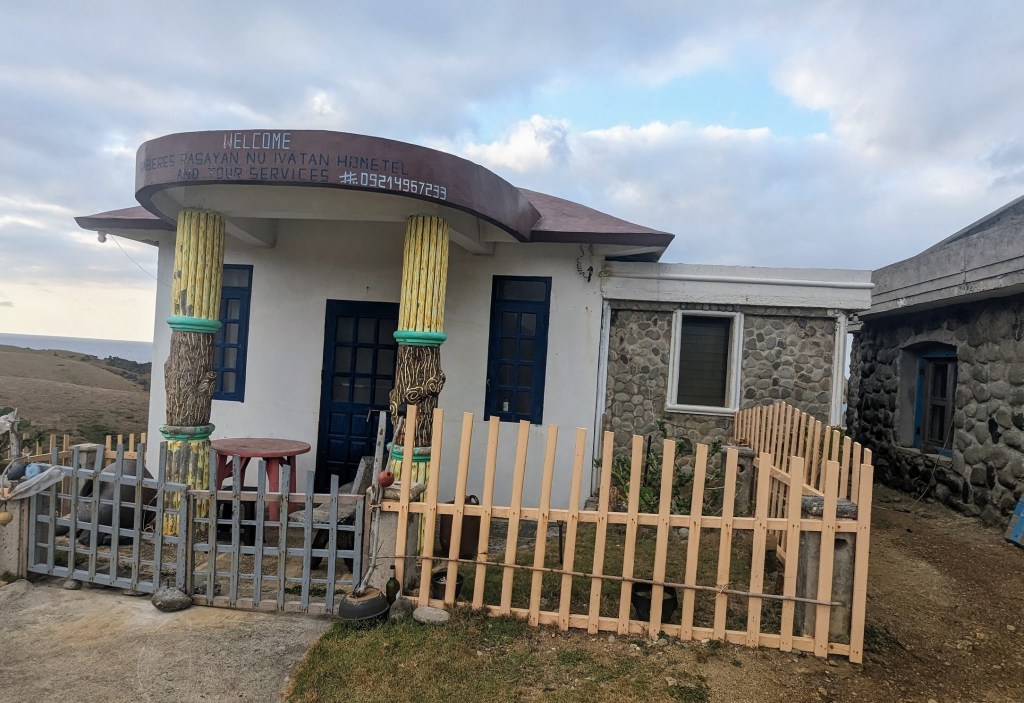
In my case, however I was very happy staying at Pananayan Pension House. I liked this guesthouse a lot not: both because of its superb location and amenities (you wont find many accommodations on Sabtang with private showers and airconditioning). But the best thing about Pananayan Pension are its owners: Pending and Fafa. A husband and wife, they are proud to be real “Sabtenos” and do their best to introduce visitors to Sabtang and accommodate them in a way which would be both comfortable and memorable.

This day, I was the only overnight visitor at the guesthouse, but a few neighbors came to Pending and Fafa: I felt that Pananayan Pension was also a little bit like a local social club. I joined locals for a glass of beer and some stories about island living. Later, Fafa served me an excellent home-style lobster dinner and this was the end of the very fulfilling day on Sabtang. If you decide to visit Sabtang and stay at Pananayan Pension, contact Pending at +63-929-667-6775.

Next day, early morning, I took a boat back to Batan. Unlike onward journey which was shared with many tourists, only a few locals were at the port waiting for the crew to load the boat with empty barrels (which will be filled with the fuel and brought back to Sabtang).
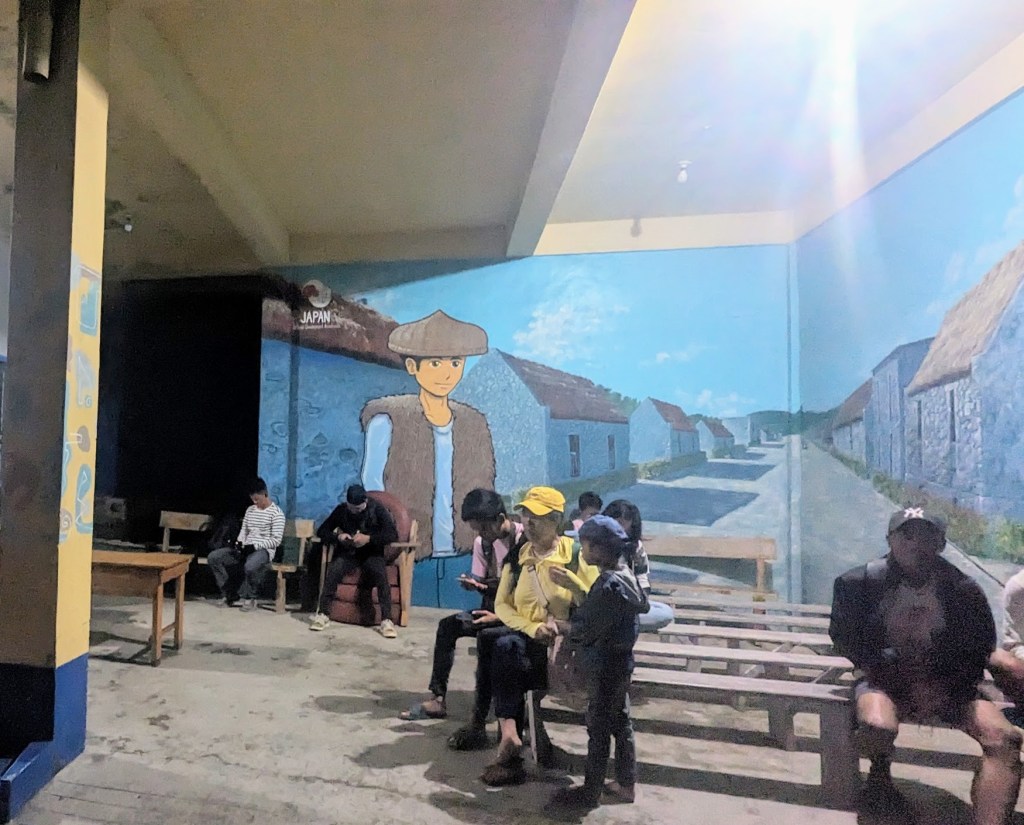
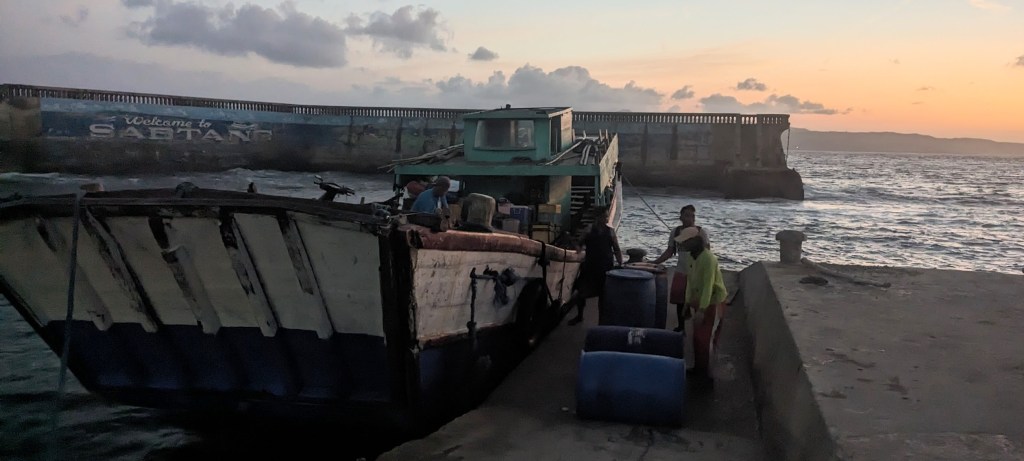
Leaving Sabtang, I thought: “The life on this island might be fairly spartan and the nature here is not always friendly to humans. Yet, it has been a while that I sensed so much peace being in a close-knit community where everyone can rely on each other when needed.”
For remaining two days on Batan, I decided to stay in provincial capital Basco: geographically, it is the best option to explore the entire island. On Booking.com, I found a place called “Horlina’s Homestay,” and for about $32 per night it was a great choice. I had an entire appartement on the second floor of a cottage which was surrounded by a garden. In addition to air-conditioning, hot shower, and fully equipped kitchen, there was also “a cherry on top of a cake:” – a furnished outside veranda decorated with flowers.
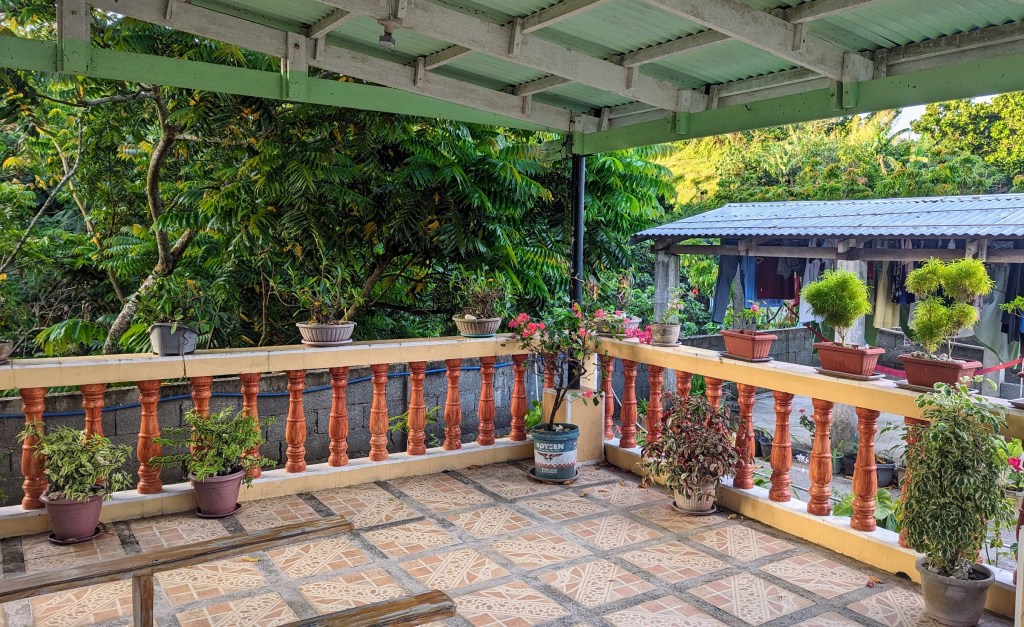
Also, it felt like a “homestay,” because Horlina and her husband lived in an adjacent house and were always happy to answer any questions or help with various requests (a free ride to various places in town, transfer to airport). Horlina’s husband owned a small fruits and vegetables shop operating right out of the house: hence, there was no need for me to go to the market. As to Horlina, it turned out that she was a devoted gardener and flowers were everywhere. If you decide to visit Basco, stay at Horlina’s place. You can send her a message at: +63-921-762-9373.
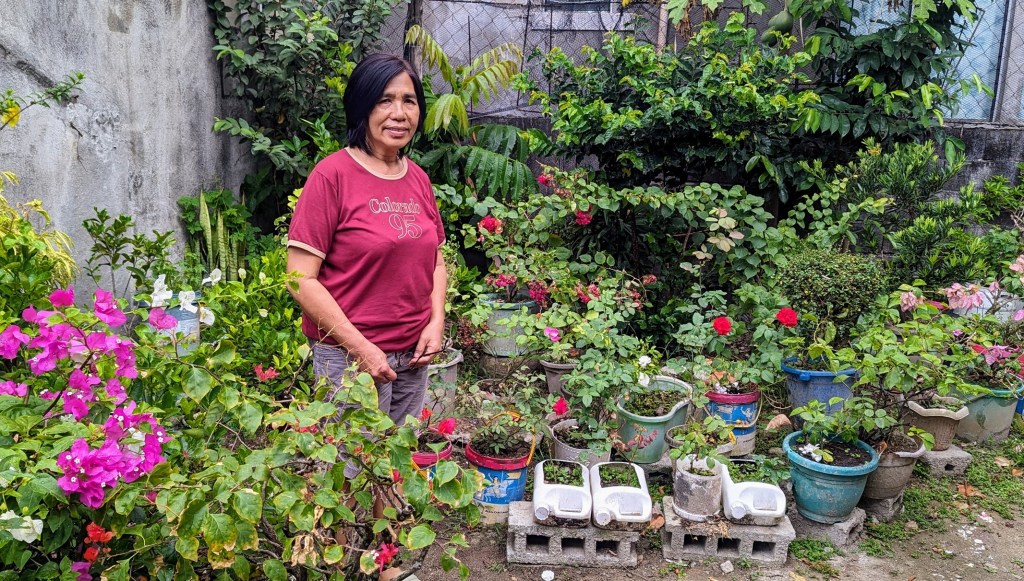
Basco is the capital of the Batanes province. With population of about 10,000, it is a very safe and and easy-to-walk town, but, except the ceremony of flag raising on Mondays (I wrote about it at the beginning), there is little to see there. All interesting destinations are outside of town.
As everywhere in Batanes, the best option to get around are tricycles. They are operated by licensed drivers and have on display the prices for various points out of Basco which depend on a distance. In addition, you can privately negotiate with a driver the costs for waiting for you if you want the ride back.
On the first day, I went to a coastal fishing village of Uyugan. It is about 16 kilometers / 10 miles long journey which lasts about 40 min. Too slow, you think? Well, although the roads are good on Batanes, they are also fairly windy: speeding up is not a good idea. Traveling here, you will see often a warning sign saying “Blow UR horn!” In fact, it became nearly a motto of Batanes with many tourists shops selling T-Shirts and refrigerator magnets displaying this message.

There were to reasons to choose Uyugan as a starting point for exploring Batan. First, this village is home to the National Museum of Batanes which is a good place to spend couple hours and learn about various aspects of islands’ past and present. Second, Uyugan is located in the southeast part of Batan, whereas Basco is in island’s northwest corner. And so, such a trip is an excellent option to get a first impression of the scenery of the entire island for less than USD $8.
After Uyugan, the driver dropped me at a place called “Marlboro Country.” Essentially, it is a viewing point and a short hillside trail which – arguably – offers the “best picture-perfect” views of Batanes: pastoral emerald green meadows, lighthouse, cows, and a deep-blue ocean with a shore-line interspersed with villages and lagoons. Marlboro County is right next to highway and, predictably, a “must stop” for all package tours on Batanes. However, the views from there are really good.

After Marlboro County, the plan was to go to the fishing village of Diura (I will explain “why” in a minute) which I could actually see from the view point.

Going to Diura from Marlboro county by a road was like making a big (4 kilometers / 2.6 miles) loop. Instead, I decided to find a path straight down: through the thick bushes, ravines, and hidden cracks between the rocks. I would not recommend to my readers to do the same (it was strenuous), but in about 30 minutes I was in the village.

Descending from the slope and coming out of forest, I entered the village through someone’s private backyard. An elderly man sitting on the porch of his hut looked at me indifferently and did not say a single word (although I tried to greet him and apologize for intrusion).

The reason for coming to Diura were natural springs called Rakuh-a-Idi or the “Spring of Youth.” They are located right next to the ocean and about half kilometer / one-third of a mile past the village. A big pool made out of solid stones was filled with cool fresh water, surrounded by the palm trees, and offered relaxing view of the ocean.
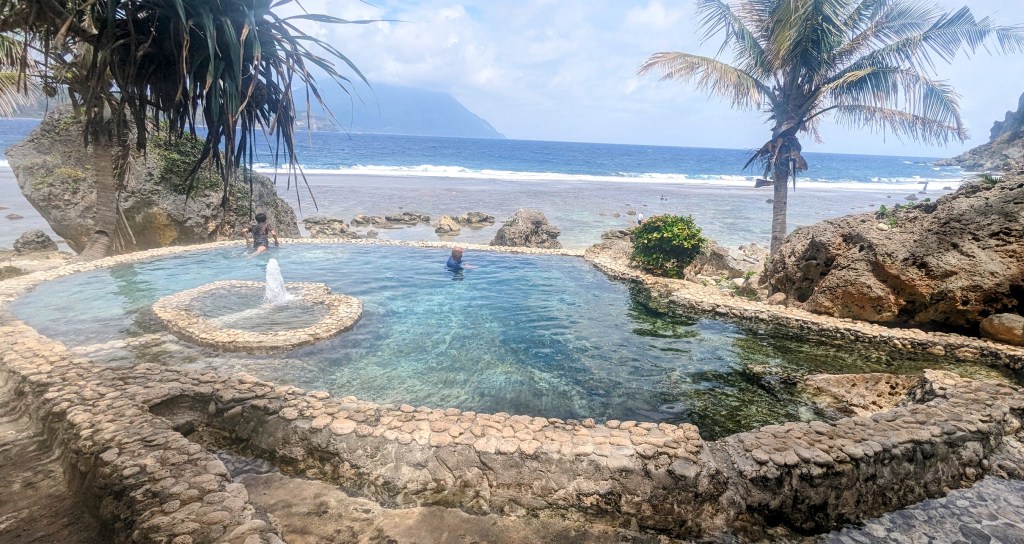
I swam for a few minutes and then took a nap in one of gazebos which were built around the pool. The source of water in the pool was a stream emerging from the stones a bit up the hill. A small chapel with the sculpture of Mother of God was placed above the spring.

The beach in front of the Spring of Youth was also quite interesting: at the low tide, various rock formations looked almost like a stone garden.

After Spring of Youth, I walked back to the village and wandered around. Most houses were built in a traditional manner: with walls made out of plywood and thatched roofs out of cogon grass.

The major local crops – salted fish, onions and garlic – were drying in front of many houses.
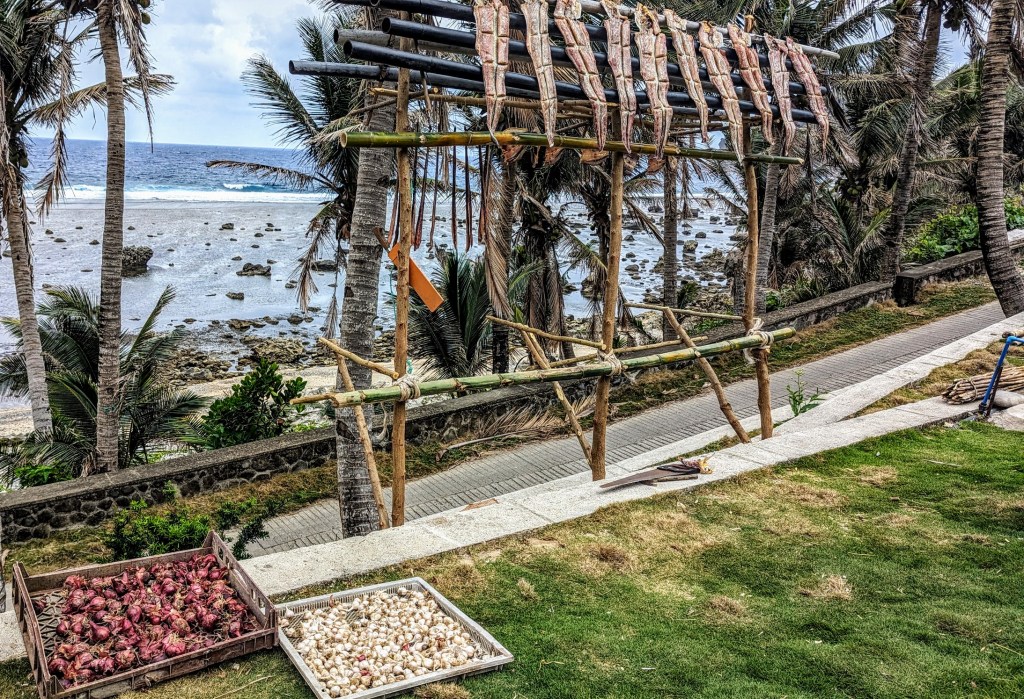
I knocked at one house and asked if I can buy a piece of salted dry fish. The young cheerful woman spoke surprisingly good English, but was very skeptical about my skills to prepare it properly. I asked for cooking instructions (which were actually very simple) and asked how much do I owe. She flatly refused to take any money despite all my efforts. We talked for a few minutes and she explained that she has several relatives from this village who live now in the U.S. and with whom she keeps in touch regularly. And then she added somewhat bitterly: “But they never come back!”
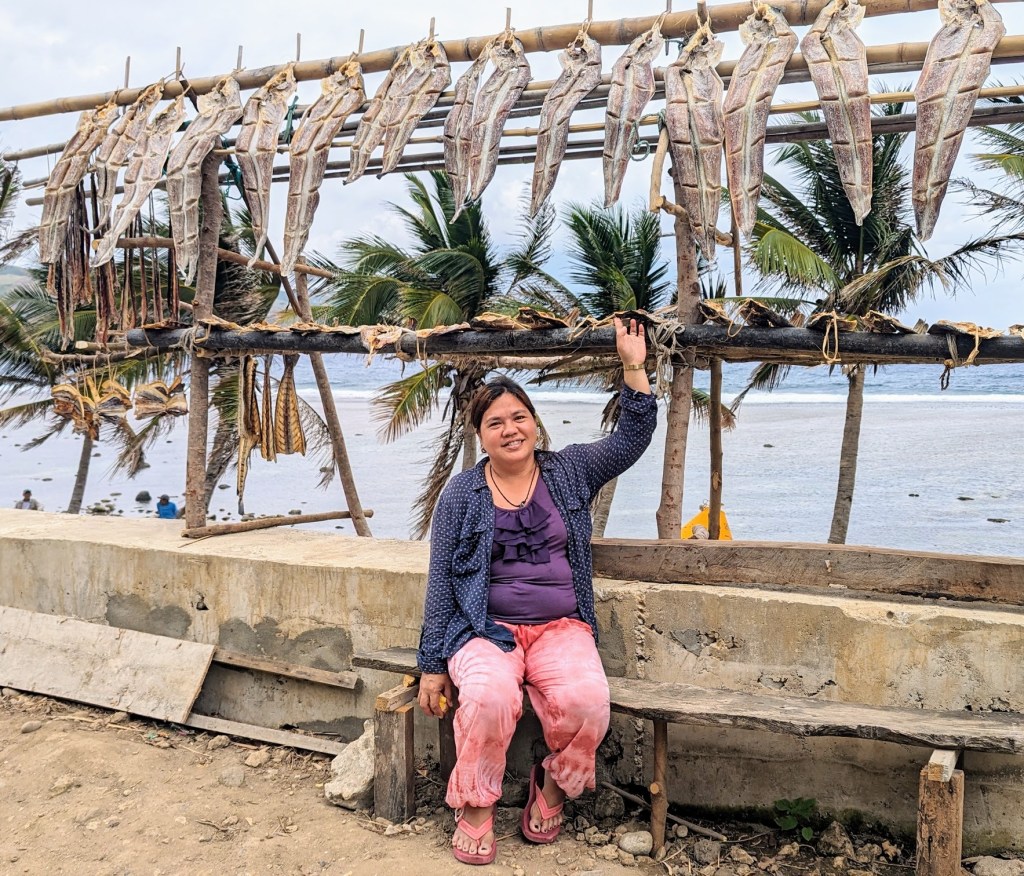
It was late afternoon, but I still two more places were on my itinerary. The first was Tayid lighthouse. It is an easy half-hour walk from Diura and by the road which is ascending back to the hills. By this time, I saw already several lighthouses on Batanes, but Tayid was still a visual delight.

From Tayid lighthouse, I planned to go to “Cafe du Tukon – Fundacion Pacita:” in a minute, I will explain what is this place about. I hiked along the road for about 30 minutes absorbing constantly changing scenery and landscapes.


But then, given shortage of time, I decided to hitchhike. Literally, the first motorbiker has stopped and gave me a quick ride to the last destination of the day: Cafe du Tukon and Fundacion Pacita. If there is a single spot in all Batanes islands which could be described as “a high end place,” this would be it. Essentially, Cafe du Tukon/Fundacion Pacita is a combination of a fine restaurant, boutique hotel perched on top of the cliff and an art gallery.
All of this is run by the family of the late Filipino-American artist Pacita Abad . An ethnic Ivatan, she was born (1946) and grew up on Batan island, studied law in Spain, received doctorate in Asian history in the U.S., traveled extensively through Asia and then, upon return to America and settling in California, discovered herself as a talented painter. She lived the rest of her life in the U.S. (mostly in Washington, DC) until premature death from the lung cancer in 2004.

With her artwork now in public, corporate and private art collections in over 70 countries, Abad is probably the greatest-ever celebrity of Batanes islands.

After she died, her vacation-and-studio house on Batan island was converted into a boutique hotel.

I walked around and admired sculptures and other artworks spread around the grounds.

Right next to the hotel, Cafe du Tukon was built: perhaps, the only “fine dining” place on Batanes.

I walked inside, sat at the table next to panoramic window, and had a cup of coffee, with hot lemon pie, and a shot of French cognac.
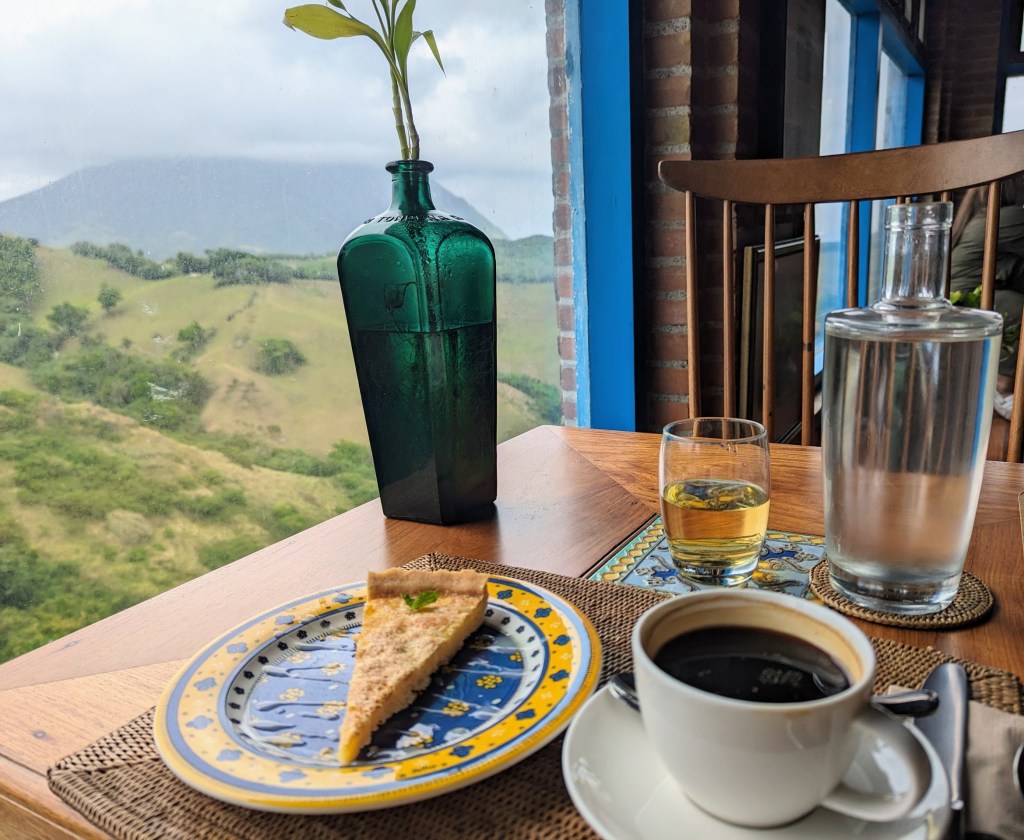
Here is menu which would give a good idea what you can get at Cafe du Tukon. Divide all prices by 55 in order to have them in USD.


It was almost dark, when I left Cafe du Tukon, but one of Cafe’s customers gave me a quick ride back to Basco (Cafe du Tukon is about 4 kilometers out of the town).
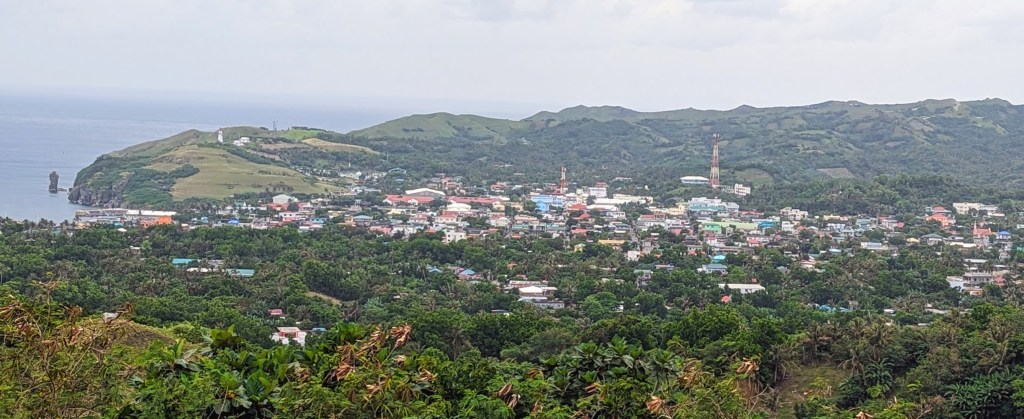
The last goal of the day was cooking an authentic Batan dish out of dry salted fish given to me in Diura. I was dead serious about accomplishing this task and followed faithfully the instructions from the woman in Diura: boil salted fish in a water for about 30 min, cut it in pieces, put on a skillet and saute with chopped onions, garlic and fresh ginger. Sounds too simple? Perhaps. But it turned out to be as delicious as if I would have my supper at Cafe du Tukon.

Next morning – my last day on Batanes – I went to see the Rolling Hills which is another “must visit” attraction. Just about 3 km / 2 miles north of Basco, it is another area which is known for its scenery: bright green hills, grazing cows and goats, and the views of the ocean and Mt. Iraya (highest point of the islands). I walked there in about 45 min.
The road to Rolling Hills is an asphalt road to allow easy and quick access for numerous minivans with tourists. At the end of the road, there is an elevated viewing platform from which visitors take their pictures. But here is the trick: do NOT stop there. Instead, continue walking and follow narrow trail which goes towards the ocean. Eventually, the trail will end, but keep going along the fence which is built on the top of the ridge.

In about 20 min you will come to the top of the hill one side of which drops into the ocean. This place offers much better panoramic views than the viewing platform built for the tourists.
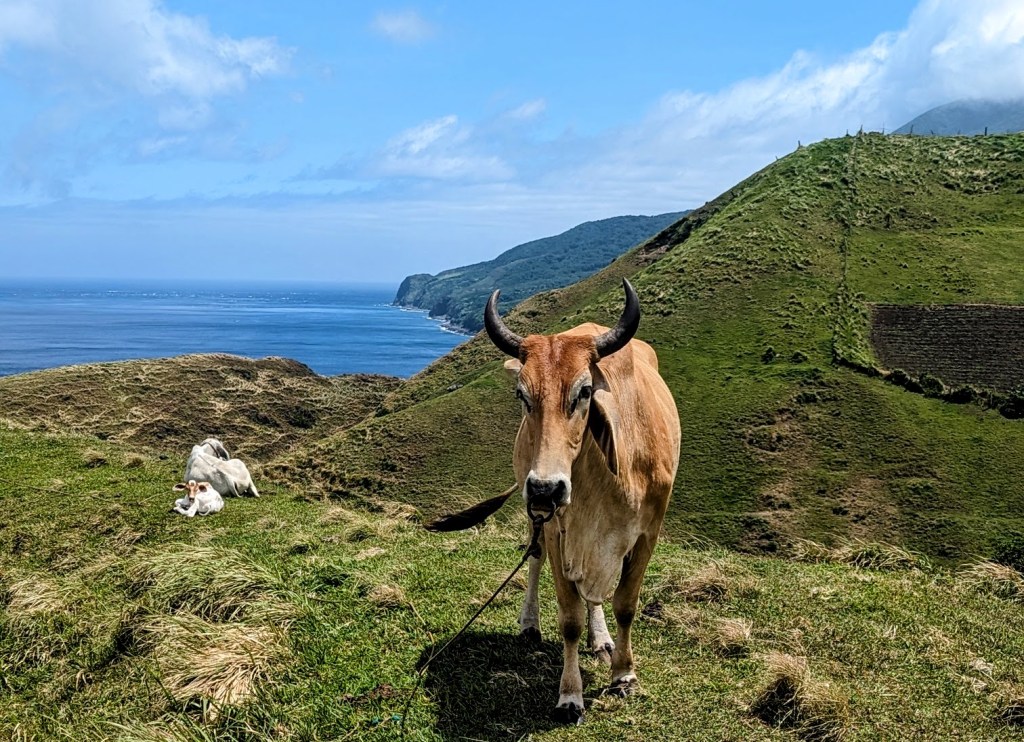
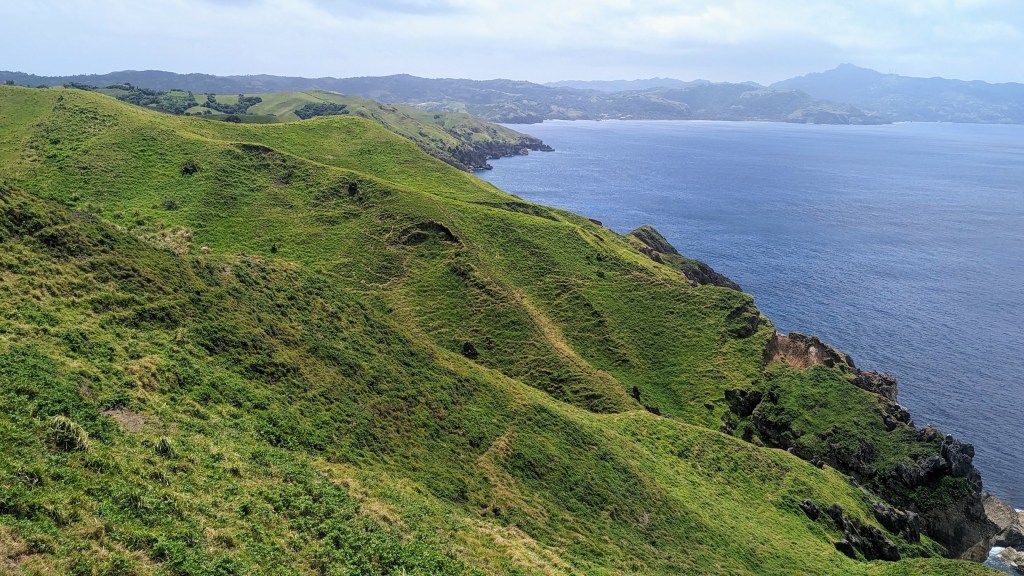
The official viewing platform is invisible from this scenic spot: tourists there cannot see you and you do not see them. It felt great to have this place and view only to myself, except for numerous graceful cows: they were coming and going without paying any attention to my presence.
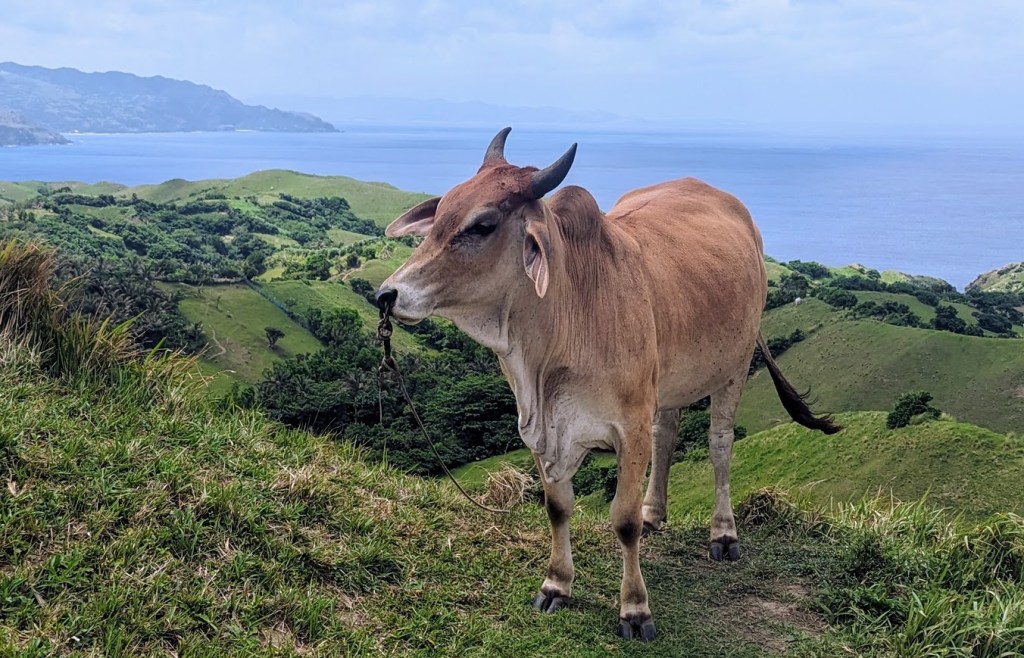
Back in Basco, I stopped by the province’s principal Catholic church – the Cathedral of Our Lady of the Immaculate Conception. First Christian missionaries to Batanes were Dominican monks who arrived here in 1783. The newly established province (diocese) of the Roman Catholic Church was named Provincia de la Concepcion. Consequently, the first church in Basco was dedicated to Our Lady of the Immaculate Conception who is regarded as the Saint Patroness of the Batanes.
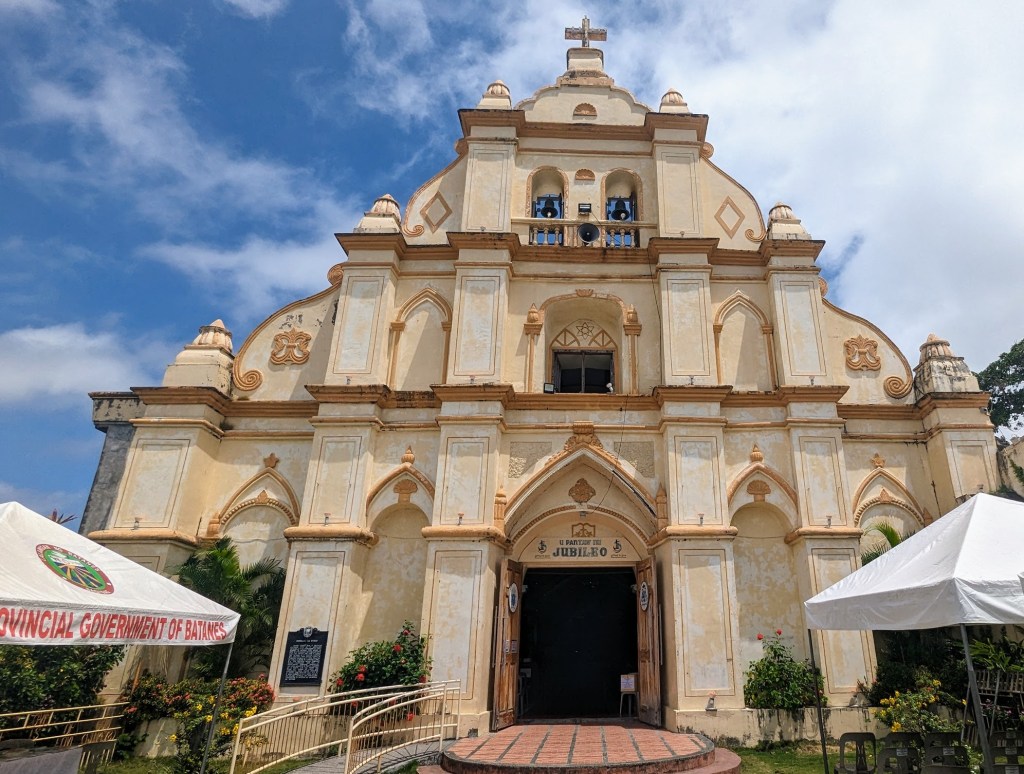
The original church building was made of wood and with a cogon roof. In 1812, it was replaced by a much larger stone cathedral. Yet, since that time, the church has undergone many changes and renovations in response to various natural disasters. Last time, it was badly damaged in the earthquake of 2000. The need to rebuild again was used as an opportunity to restore the church in its original (1812) form.
Yet, the interior of the church (especially, altar part) looks much more modern than its exterior. But I also liked this style, because of its clean and elegant appearance.
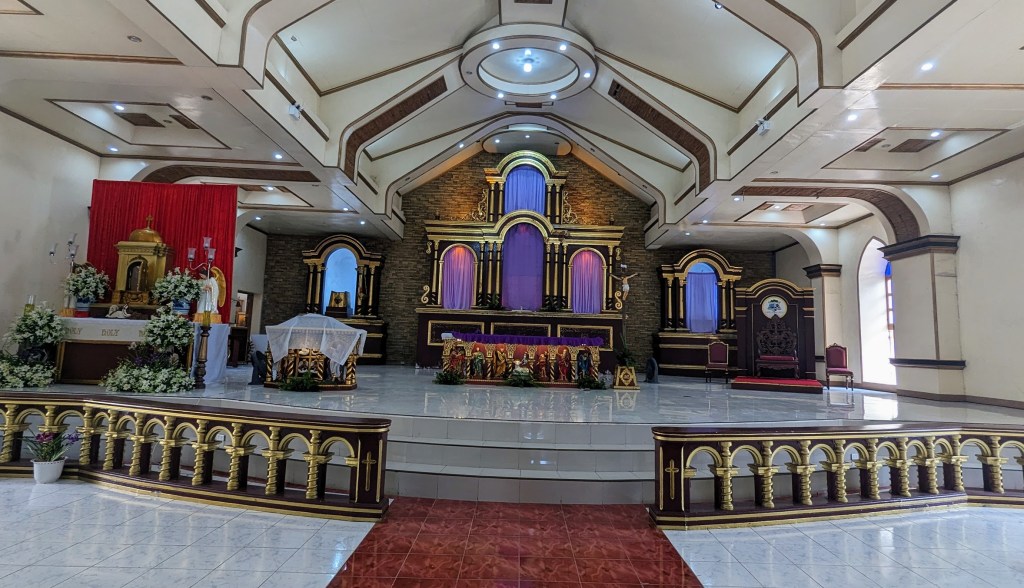
The last destination was the town of Mahatao which is on the coast between Basco and Ivana. I hired a tricycle and was there in about 20 minutes. Frankly, I did not expect much from this visit and simply wanted to walk around and look at the local life. It was about 5 pm, when I heard bells ringing. These were the bells of San Carlos Borromeo church in Mahatao, another fine example of Spanish colonial architecture.
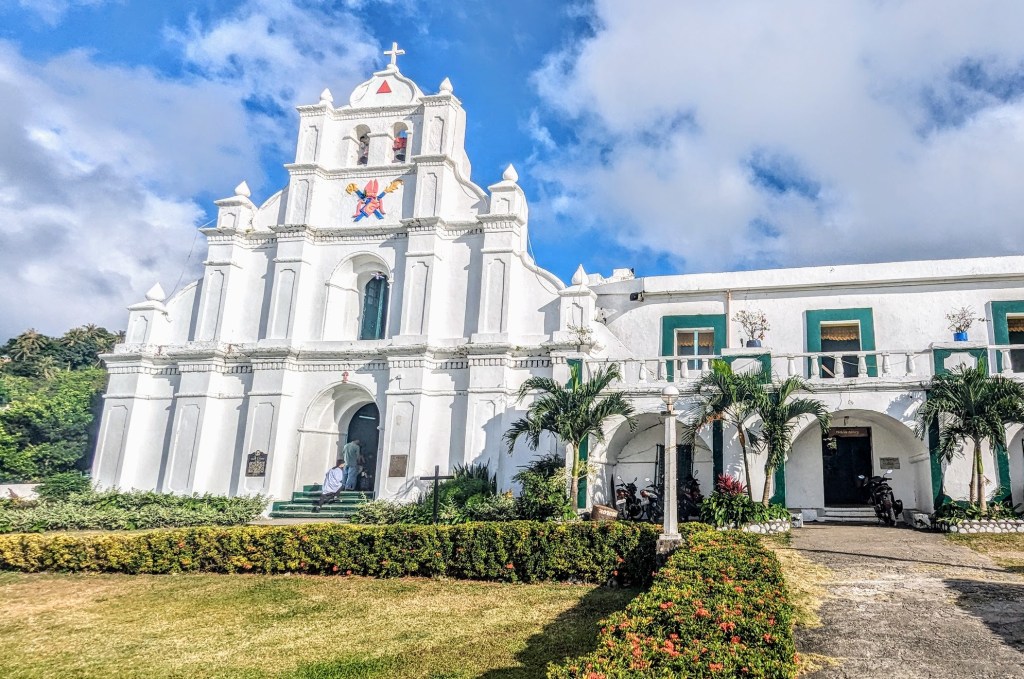
Inside, it looked more traditional and original than Cathedral in Basco.
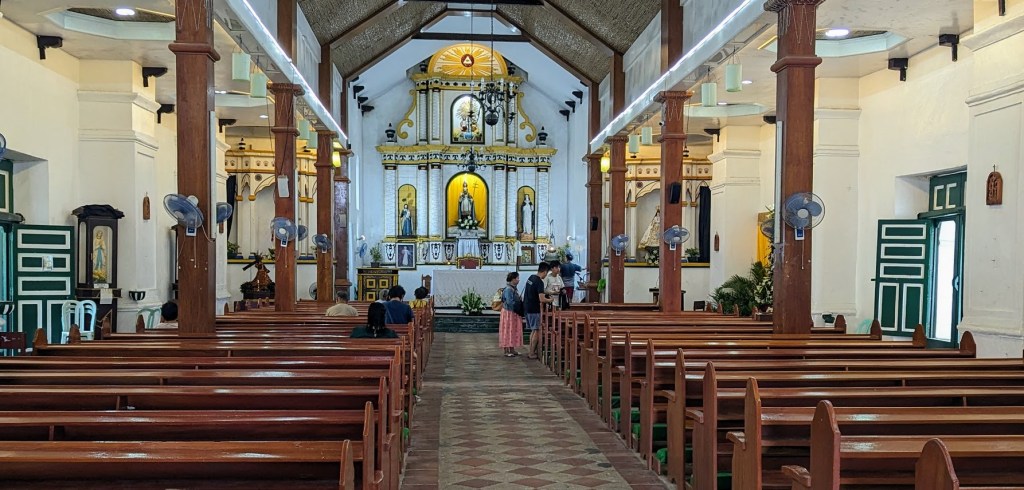
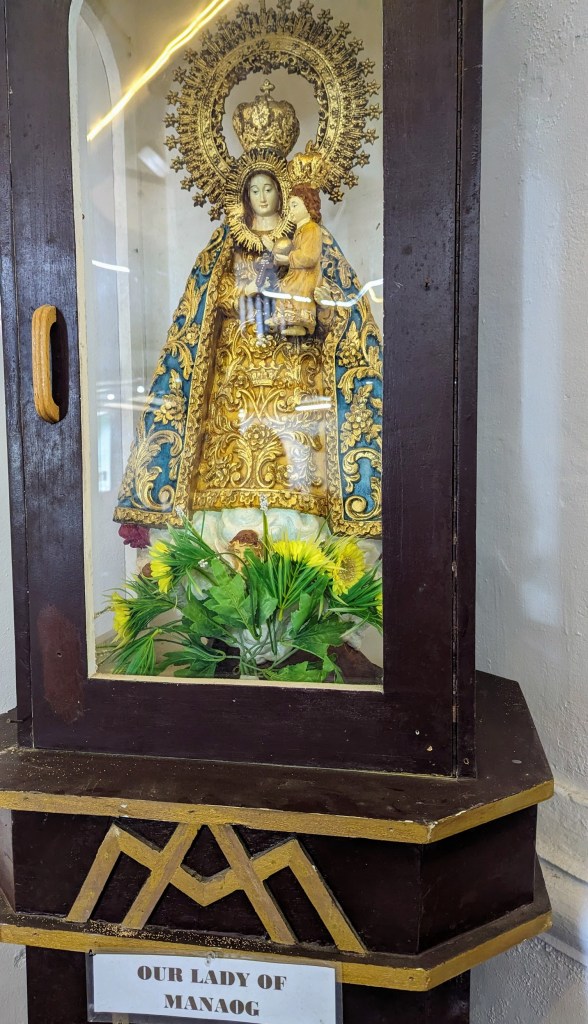
The bells were calling for the service and in about 10 minutes the church was full. To my surprise, a lot of young people came to worship.

It was the week right before Easter, and the service was especially solemn and colorful: with processions and many altar boys participating.
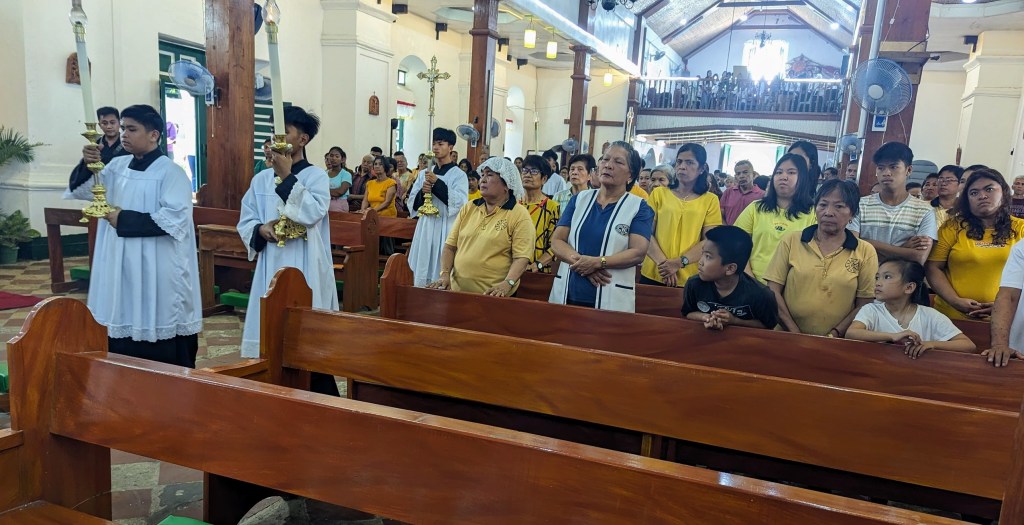
The quality of church choir was also impressive: it sounded as a fairly professional performance. I walked to the back and climbed the stairs to the second level to see the performers. The people playing music and singing were the local young boys and girls. Choir area was also a good point to take another picture.

I stayed until the end of the mass and was the only non Filipino in the crowd. Yet, I felt very comfortable: the service was engaging, and the people around were smiling when I met someone’s eyes. This was also the end of my trip to Batanes and I could not wish any better place for reflection on all what I experienced during past few days.
Back in the guesthouse and while packing my luggage, I knew already that I will return to Batanes. Yes, I will go to discover new places there (first of all, the island of Itbayat), but also to simply revisit and see the people whom I met and who made me feel truly welcomed on the islands: Robert and Ofel, Pending and Fafa, Horlina, the lady who gave me fish in Diura village, and many more. See you all soon!



of
Alexei Congratulations on your visits/ trips. Good health!\ + Nathaniel
LikeLike
Please remove me from your mailing list
Fr. Michael Kochis St. Vladimir Orthodox Church 313 Ninth St. Ambridge, PA 15003
LikeLike